Same view (2016):
Same view (2016):
Same view (2016):
Same view (2016):
Same view (2016):
Same view (2016):
Same view (2016):
Same view (2016):
Same view (2016):
Same view (2016):
Same view (2016):
Same view (2016):
Same view (2016):
Same view (2016):
We get asked this question a lot from people. Most are simply curious. However, to the staff of the FSU Digital Library (FSUDL), this is actually an important question. Understanding what our most viewed objects are can help us decide what materials to digitize and make public next for our users as well as understand where current research interests lie within the FSU community.
However, it’s not quite as simple as looking at Google analytics or the basic collection usages statistics that our digital library platform gives us. We’ve only had some of our statistic reporting tools in place for a short amount of time so what Google says is our most viewed collection doesn’t necessarily match what the Digital Library itself tells us. For example, Google says that our Yearbook collection is the most viewed collection in the Digital Library; our Digital Library tells us it’s the Heritage Protocol & University Archives collection, the Yearbook’s parent collection, that is most viewed. This shows the different granularity upon which the two systems collect information; one is looking at the entirety of the Digital Library; the other is looking only at a certain level at any given time. That difference is why we need both systems tracking together to get us the information we need to make decisions about projects moving forward in the FSUDL. It’s also helping us to continue to refine how we collect usage information from the FSUDL.
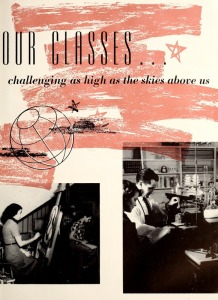
While the Digital Library platform might not be the best fit for tracking what collection is most viewed, it is the platform which can tell me the answer to the question that prompted this blog post: what is the most viewed object in the Digital Library? Right now, this still is not an easy question to answer (takes a bit of work to get it out of the DL system) but I can say that the Tally-Ho of 1952 (the FSU student yearbook) has been viewed 990 times since we started tracking at object level at the beginning of this year.
In second place is Paul Dirac’s dissertation with 755 views and rounding out the top 3 is a Ringling Bros. and Barnum and Bailey clown college (because who doesn’t love clowns?) In fact, this item is also in our top ten of exit pages meaning this object is often what people are looking for so they leave the FSUDL after finding it.
We’ll continually be working on tracking usage in the Digital Library to make sure the materials we share in the digital environment are the most useful and interesting to all our users. What do you think we should digitize next?
2016 Portals Creative Fellow Walker Mettling put together an amazing, Special Collections-themed comics compilation and story night– and you’re invited!
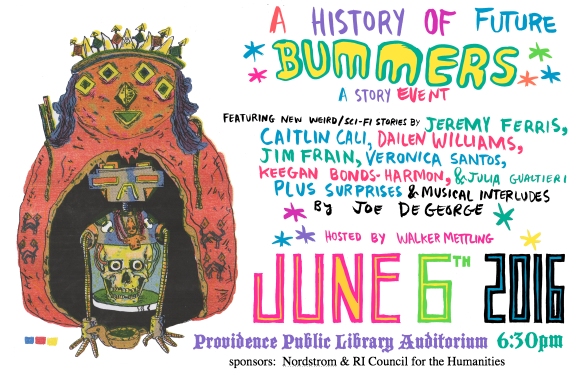
The event, coming up on Monday, June 6th, will feature stories written and read by local artists Veronica Santos, Caitlin Cali, Dailen Williams, Jim Frain, Keegan Bonds-Harmon, Jeremy Ferris & Julia Gualtieri. Library friend and neighbor Joe DeGeorge will provide musical interludes. This event will also feature the release of a brand new, Special Collections-themed issue of the Providence Sunday Wipeout, a large-format comics newspaper. Wow!
This not-entirely-literary evening will be hosted by Walker Mettling. See you on June 6th at 6:30 p.m. in the PPL Auditorium!
Yesterday, PIDB member Sanford Ungar attended a briefing by Dr. Cheryl Martin entitled, Decision Support Technology for Records Declassification Review and Release. Dr. Martin’s briefing was jointly sponsored by the ODNI and CIA as part of the research supporting the Congressionally-Directed Action tasked by House Permanent Select Committee on Intelligence to the Director of National Intelligence in Section 321 of the IAA for FY2015: Report on Declassification Process.
Dr. Martin’s briefing expanded on the findings she presented at the PIDB’s June 25, 2015 public meeting concerning declassification technology pilot projects conducted at the Applied Research Laboratories at the University of Texas at Austin. As part of the President’s Second Open Government National Action Plan, the CIA and NARA teamed with Dr. Martin and the CCU to develop a Sensitive Content Identification and Marking (SCIM) tool to assist the declassification review of over 87,000 emails from the Reagan Administration.
After successfully demonstrating the capabilities of the SCIM tool, the CCU continues supporting the CIA in its efforts to develop and apply the technology to its declassification review processes. Dr. Martin’s briefing brought agency officials together to hear an in-depth description of the piloting efforts and to discuss as a community the potential next steps for developing the SCIM tool and expanding its application at agencies.
The PIDB has a history of making recommendations for improving technological capabilities in support of declassification. The work of the CCU will have significant implications on how agencies grapple with the challenges of performing declassification in an increasingly digital world. The new challenges brought on by the exponential growth of digital information require new solutions routed in technology and automation. Not only will technology support declassification decision making in the future, it likely will replace some components of the declassification process in its entirety. Developing these technologies requires new policies that favor an increase in automation and improved risk management across government. As importantly, agencies requires resources (i.e. funding) devoted to declassification modernization to ensuring the public has access to government information now and in the future.
The PIDB thanks Dr. Martin and the CCU, as well as the ODNI, CIA, NARA, and all the agencies who attended the briefing. The participation of agencies at this briefing and at the meetings of the PIDB’s Declassification Technology Working Group demonstrate the commitment the government shares to improve public access to its information in support of transparency and openness.
![]()
One of the most rewarding parts of my work is sharing the treasures of the National Archives with kids and their families.
Through the support of the National Archives Foundation, we continue to host sleepovers in the Rotunda of the National Archives. These events give kids the chance to spend the night next to America’s most precious treasures: the Declaration of Independence, the Constitution, and the Bill of Rights, while engaging them in activities that help them learn about our nation’s history, and explain the important role of the National Archives.
One of the activities during our sleepovers provides an opportunity for kids to write letters, as I did, to the President of the United States, which are then delivered to the White House.

Kids at the National Archives sleepover write letters to the President of the United States. February 6, 2016. Photo by Jeffrey Reed.
Our latest delivery received a response directly from the President!
It is a privilege to continue to host these events for kids and their families, and encourage them to become more involved in their government. For more information, please visit archivesfoundation.org/sleepover.
![]()
“Race Relations in America,” is the self-proclaimed theme of the 1962 Anisfield-Wolf Book Award winners. The prize, whose mission is to recognize works of social justice, goes to three books, Black Like Me by John Howard Griffin, The Forbidden Man, by Gina Allen, and Anti-Slavery: The Crusade for Freedom in America by Dwight Lowell Dumond.
As the books represent three different genres (memoir, novel, and work of history) the host has a difficult time getting the conversation going. Gina Allen speaks of her novel being about how “barriers lead to a lack of understanding, and in the lack of understanding you have the germs of hate.” Dumond, a professor of history, starts out with a rather dry exposition of the anti-slavery movement, before characterizing the institution itself as “a form of social insanity.” Griffin, the most well-known of the three, whose “stunt” of having a dermatologist to darken his skin so he could travel throughout the South as a black man, is a more passionate, voluble witness.
Griffin describes the hardship of simply having nowhere to eat, to get a glass of water, or answer any other bodily needs, of the dread he felt leaving his room, of having to think very carefully before taking any action, with the threat of violent consequences lurking behind the most innocent impulse. Of blacks and whites in America he proclaims, “We know nothing whatsoever about each other!” Allen refers to an apparently common phrase of the time, the “hate stare” blacks encounter from racist whites. She also points out how racism destroys white families and as well as black. Dumond speaks of the brain drain the South has suffered for many years as any white with the conscience or intelligence to question the system of apartheid is forced to leave.
There is still, in 1962, a widely-held belief that the Negro is genetically inferior. Much time is devoted to debunking these and other myths. Griffin speaks of how, when hitch-hiking, he was invariably asked about the black man’s enormous sexual appetite. The conversation, with its conspicuous lack of black representation (this in a year that saw the publication of James Baldwin’s Another Country) is a well-intentioned but disturbing snapshot of the white literary community trying to formulate a response without engaging the very people whose predicament is being discussed.
Gina Allen (b. 1918) was the author of many books and articles. The Forbidden Man was her first novel. Kirkus Review called it:
An earnest, angry and often moving novel about integration in the Spanish-White-Negro-town in the southwest…There is a touch too much melodrama and too many side plots in this story, but the author has right, knowledge and indignation on her side, and the central scenes, of a Negro teacher at bay among the disturbed from an even more disjointed background, are frequently stirring.
Dwight Lowell Dumond (1895-1976) taught for many years at the University of Michigan. Anti-Slavery was his magnum opus. As the university’s memorial tribute notes:
Dumond’s antislavery publications were cited in oral argument by counsel for the plaintiffs in the school segregation cases to supplement their written briefs.
John Howard Griffin (1920-1980) was a novelist, journalist, and social activist. It is hard to overstate the impact Black Like Me had in a time when the inequities of the South were not widely reported and, even when done so, not widely believed. Something about the bizarreness of Griffin’s self-willed transformation, perhaps the very urgency such a drastic act implied, made his revelations more than mere muckraking. Jonathan Yardley, book critic for the Washington Post, recalled its effect when revisiting the book fifty years later.
I was 21 years old, newly graduated from Chapel Hill. I had written sympathetically about the emerging black protests for the student newspaper, but I was deeply ignorant about the truths of black life in America. That it took a white man to begin my awakening is, in hindsight, distressing, but Griffin’s story managed to put me in a black man’s shoes as nothing else had. …”Black Like Me” had a transforming effect on me, as apparently it did on innumerable others. That it has remained in print for more than four decades is testimony to its continuing influence, in great measure because it is taught in high schools and colleges.
Fittingly, the last word is given to Griffin, who states, “We don’t have a race problem in the United States, we’ve got a problem of racism.”
Audio courtesy of the NYC Municipal Archives WNYC Collection.
WNYC archives id: 150268
Municipal archives id: LT9452

“I left Harpoot the 17th of May, going alone three days’ journey to Diarbekir, somewhat to the scandal of the missionaries along the way. However, I knew the road well and was not in the least afraid, and after all nothing happened.” (Dora Mattoon, letter of Dec 3, 1915)
What inspires a woman to throw over her life from one day to the next, to go from apparent comfort and a great job in a big city to a remote post in a country she’s never been to, where they speak a language she hasn’t studied at all? And what would possess her to leave the first country after five years of hard work for an entirely different one, retraining herself all over again? How does she go from here:

to here:
–and from being this person (I love the body language here):
 What percent of her decision springs from a spirit of adventure, and what percent from “missionary zeal”?
What percent of her decision springs from a spirit of adventure, and what percent from “missionary zeal”?
In the case of Dora Mattoon, it was 110% of each. She couldn’t be contained.
On March 2, 1911, the 27-year-old Dora read an obituary in the New York Times for missionary Maria B. Poole. Maria, who had earlier attended Dora’s church, the Broadway Tabernacle, had died at the mission station in Harpoot, Turkey, of a heart attack after complications from pneumonia. According to Dora’s diary, the story of Maria’s life and work inspired Dora to take her place, almost from one day to the next. She thought quietly over the idea for a few months before announcing her decision in early May. Dr. Charles Jefferson, her pastor at the Broadway Tabernacle, wrote to console her worried parents:
“Your daughter seems to have worked this problem out all by herself. I never once spoke to her on the subject of missions, and was quite surprised when a short time ago she came to me, and told me she was going to apply for the position left vacant by our missionary, Miss Poole. I do not believe that anybody talked to her, or coaxed her into it, or even persuaded her, but that she worked it all out alone in her own heart. And she seems to be quite firm in her decision, feeling convinced in her own mind that she is doing what is right and best. She does not like to go so far from you and her mother, but she feels that you have four other girls… Under the circumstances, then, I do not see what is to be done but to let her carry out her plan. She is a mature woman, in good health, old enough to know her own mind, and to measure her own powers, and however hard it may be for you to have her go so far from you, I believe that in time you will become adjusted to it… She can write to you often, and every seven years she can come home… Having been in Turkey once myself, I do not think of it as far away.” (Letter of May 2, 1911 from Charles Jefferson to Alfred Mattoon.)
By October, Dora was on a ship heading for Turkey to take Maria Poole’s place in Harpoot.
Dora thrived in Turkey. She loved the people – the natives and her colleagues – and she loved the work. Her particular job was to be a touring missionary, to visit small villages in the region and to meet with the “Bible women” there. The Bible women were native Armenians who taught Bible lessons to their fellow citizens for a small salary, and it was Dora’s job to be sure they had what they needed, spiritually and materially. At first she used an interpreter, but over time she learned Armenian and Turkish and was able to conduct meetings herself.
Dora’s work required that she travel from Harpoot across land that was often dangerous from snowstorms, rainstorms, flash floods, and dense fog, not to mention Kurdish tribesmen, who in Dora’s letters seem to alternate between rescues and robbery. Dora traveled by horseback, often for days at a time between one village and the next, and for months at a time over the course of an entire tour. Finding shelter usually meant a stay in a native khan (an extremely rustic inn) where she would share a blanket with fleas on the floor in a smoky, windowless room, separated from other occupants by a blanket curtain. She almost always had a male escort, usually the long-time missionary Henry Riggs, but occasionally she went alone on shorter trips or was accompanied by Mariam Varzoohi, a native teacher in the girls’ college. Dora traveled across hills, jumped off falling horses, waded up to her thighs in snow, got soaked to her skin, and seems to have relished all of it. Whether she’d been a mountaineer before she came to Turkey or whether she realized her love for it in Harpoot, it became a lifelong attachment.
![“The northern way is pleasanter than the southern in that one passes over mountains most of the way, and the khans are better on the whole…I was absent from Harpoot almost five weeks, and two days was the longest time I spent in any one place, so you may know life in one way did not become monotonous. Our principal topic of conversation between here and Sivas was our rascally arabdaji [guides]. This was my first experience of travelling in Turkey without a man, and I find a woman has to do a deal of fighting to get along alone.”](https://consecratedeminence.files.wordpress.com/2016/05/turkey-no596.jpg?w=500&h=286)
“The northern way is pleasanter than the southern in that one passes over mountains most of the way, and the khans are better on the whole…I was absent from Harpoot almost five weeks, and two days was the longest time I spent in any one place, so you may know life in one way did not become monotonous. Our principal topic of conversation between here and Sivas was our rascally arabdaji [guides]. This was my first experience of traveling in Turkey without a man, and I find a woman has to do a deal of fighting to get along alone.” (Letter of Nov 13, 1913.)
The work of a traveling missionary was Dora’s favorite work, “the cream of missionary work,” but with the departure of several colleagues from the station she had to give it up in order to teach at the girls’ school in Harpoot. She loved this work too, but she never ceased to miss touring, which seems to have been the highlight of her career. Nevertheless, she threw herself into teaching with enthusiasm, embracing her “eagerness to tread in unknown paths.”

“You ask about my orphanage correspondence. Our orphans are each supported by people in America, and so every once in a while I have to get the children to write letters to their caretakers, have the letters translated, and send them off with a personal word of my own.” (Letter of Aug 14, 1913.)
Harpoot’s attractions included Earl Ward, who had been in Turkey since 1909. Dora had met Earl’s twin Mark (both Amherst Class of 1906) before she left for Turkey, so finding Earl at Harpoot would’ve been no surprise. Falling in love with him might’ve been a surprise, though:
“You remember, mother, I used to say men were a nuisance – though I did find them ever so good chums as you know…” (Letter of Oct 17, 1912.)
“Mark [Ward] talked to me more than once about Earl and how much he needed me, though I wouldn’t have it that way at all and came out here with my mind fully made up that whatever happened I simply wouldn’t marry Earl Ward.” (Letter of Oct 17, 1912.)
“…his faults loomed clearer than his virtues for some time!” (Letter of Aug 14, 1913.)
Good chums Dora and Earl worked and played together for the few years they overlapped in Harpoot.

“I hope none of you in this enlightened age and generation picture a missionary as a man who wears a frock coat and a long face and goes around preaching of fire and brimstone. The missionaries I have known are the finest, most earnest, whole-souled, jolly people I’ve met in many a long day.” (From left, Dora, Mary Riggs, Earl. Letter of Mar 1, 1913.)
Earl’s tour in Harpoot ended in July of 1913, when he returned to the U.S. and began to work for the YMCA. When he left, Earl and Dora were already engaged and planned to marry when Dora’s tour was up a long two years later.
Dora left Turkey in the spring of 1915, by which time the war had reached Harpoot. That winter, from her home in Massachusetts, she wrote to her sisters, reflecting on what had happened in the brief time since she’d left:
“I wonder where all those dear [Harpoot] friends are now? Many if not most of them killed, I suppose. How dear they all were, and how I loved and admired them! When I came away three of our professors and one of our teachers were in prison, along with eight or ten others of the prominent Armenians, and torture and massacre and deportation had not yet then begun. They came with full force later!” (Letter of Dec 3, 1915.)
In March of 1916, after a brief furlough in the United States, the newlyweds headed for Calcutta, India, on YMCA business. It’s difficult to be certain from only her letters home, but at first Dora seems to have struggled to find her place in India. The climate was hard on her, but in addition she seems to have become an adjunct to Earl’s work in Calcutta rather than having her work equal to his as it had been in Turkey. Her letters suggest that her role was to be primarily a helpmeet to Earl, especially as hostess to people associated with his work, and to do this work so regularly that it was exhausting. Dora needed to be busy, to do her own work, and to feel useful, and while she loved Earl and supported his work, her frustration is apparent in her letters to family.
After a few years and another brief furlough, the Wards were sent to Bombay, and here Dora seems to have gotten back into a role she loved. While Earl devised programs for men and boys, Dora did the same for women and girls. Their duties introduced them to the “chawls” in neighborhoods where their work would take place:
“The chawls are great blocks or tenements of concrete, four storeys high, with twenty rooms on a floor and about five persons to a room probably! We figure there are about 8,000 people in the 22 chawls in that particular area.”
The Wards also traveled around India to inspect other social work sites:
“We had three weeks in Nagpur and spent practically all the time studying the welfare work. I visited the day nursery, or creche, which is being done at the mill, and I also spent some time at an infant welfare center which is being run by the municipality. Then I went to the villages with Irene’s trained nurse and some of her teachers, and Earl spent a lot of evenings, and I some too, visiting the night schools, which is the big approach to people. The welfare work is financed by Empress Mills, who employ 25,000 workers. They live in villages, or bustees, and the welfare work is being done in the bustees. I also looked into the Project Method of teaching…”
Dora was back in business. Click on an image below for gallery.






During vacations the Wards traveled in India as they had in Turkey. Over time Dora became “an old India hand,” familiar with the ways of India – its history, religions, customs, foods, and how to get around. Click for gallery:









After another tour of duty in Calcutta from 1930-32, the world economy forced the YMCA to downsize and the Wards were called home. They were never again posted abroad but remained very active in the U.S. with social work similar to what they had done in Turkey and India.
The Dora Judd Mattoon Ward Papers contain diaries, correspondence, photographs, a nearly full set of the “Harpoot Newsletter” by Ernest Riggs, and other materials about the lives of Dora and Earl Ward. One of its chief strengths is in showing how the lives of missionaries evolved in response to circumstances and changing needs. Dora and Earl started out as “missionaries” in Turkey, but in India they referred to themselves as “social workers” or “welfare workers,” and their work seems distinctly less religious and more specifically related to health, education, and welfare. Where Dora’s work as a touring missionary in Turkey involved a lot of religious teaching, her work in India was more about setting up programs for women and children, and Earl’s was the same for men.
The papers are also important as a record of events in Turkey and India in the first third of the twentieth century. Although the couple seems not to have been especially “political,” their letters contain many comments about the state of affairs first in Turkey during World War I, and later in India during the declining years of the British Raj.
We welcome researchers seeking to use the many Ward collections at Amherst College — those of Edwin St. John Ward (AC 1900), Earl Ward (AC 1906), Mark Hopkins Ward (AC 1906, his papers to be processed soon), and Dora J.M. Ward — or one of the many other missionary collections in our holdings.
Note:
Most of the photographs in this post are by Earl Ward, a few probably by Dora Ward or Fay Emmett Livengood, a fellow missionary in Turkey. Many of Earl’s photographs, including several used in this post, were digitized by his nephew Richard Ward, Class of 1942.
All of the letters in the Dora Judd Mattoon Ward Papers were transcribed by Dora’s faithful niece and our donor, Nancy Kline.
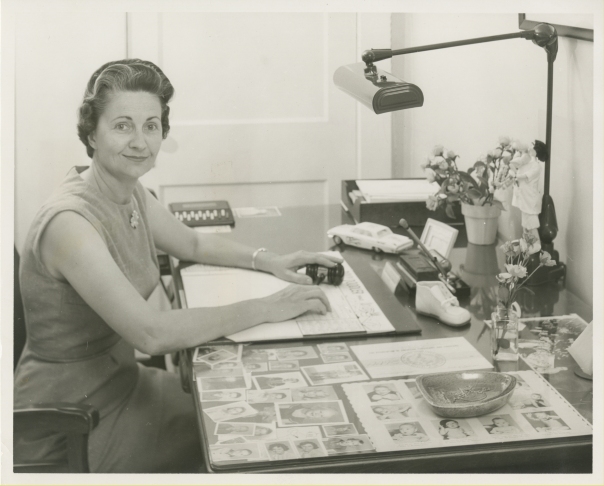
We are excited to announce that the Charlotte Edwards Maguire Collection is now available in the FSU Special Collections & Archives! This collection documents the involvement of Charlotte Edwards Maguire (1918-2014) in the development of the Florida State University College of Medicine through meeting minutes, correspondence, program pamphlets and flyers, photographs and reports. The collection also includes documents from her non-FSU professional endeavors, as well as personal photographs, correspondence, drawings, and more.

Born in 1918, Charlotte Edwards Maguire was a distinguished pediatrician and early supporter of the FSU College of Medicine. After receiving her bachelor’s degree from Memphis Teachers College in 1940 and her medical degree from The University of Arkansas in 1944, she opened her first pediatrics practice in Orlando, FL. She served as the director of the Orlando Child Health Clinic, chief of staff for the Central Florida Division of Children’s Home Society Florida, and was the first woman president of the Florida Pediatric Society in 1952. Dr. Maguire was a pioneer for women in the medical industry, but was almost prevented from pursuing the field due to prejudice from the faculty at the University of Akansas. Often singled out for being the only woman in her field (and regularly referred to as “Girl Doctor” in newspapers), Dr. Maguire carved out a niche for herself and began to influence the medical industry in Florida.
In 1999, Dr. Maguire donated $1 million to create the Charlotte Edwards Maguire Endowed Scholarship Fund. Maguire’s dedication to the FSU College of Medicine earned her the nickname “Mother of the FSU Medical School.” Dr. Maguire was also heavily involved in the development of the College of Medicine, advocating for the institution and mentoring students in the program. In 2002, Dr. Maguire was awarded an Honorary Doctorate in Humane Letters by President Sandy D’Alemberte, “making [her] Dr. Dr. Maguire,” and had the distinct honor of having the FSU Medical Library named after in 2005.
To see more photographs, ephemera, and artifacts related to the history of Florida State, check out the FSU Heritage Protocol Digital Collections or like the Heritage Protocol Facebook page.
The following testimony is excerpted from the U.S. Senate Committee on Interstate Commerce hearing on S. 814 to amend the Communications Act of 1934, December 8, 1943.*
My name is John V. L. Hogan. I am by training and occupation a consulting engineer. I have been interested in radio, first as an amateur, as far back as 1902. My first professional connection was with Dr. de Forest. That was when I was still in school. I was his laboratory assistant.
I left Yale to join the National Electric Signaling Company as a telegraph engineer, and then I worked through the position of chief research engineer and finally manager, and then, in 1921, just before broadcasting became a beginning industry in the United States, I established my own practice as an independent consulting engineer with a laboratory and office in New York, which I still maintain.
I happen to be the controlling stockholder of Station WQXR in New York, which was an outgrowth of laboratory work in television, strangely enough. We had an experimental sound channel as a part of our television work and it was found that radio listeners who had no television receivers could hear the sound portion of our program, even though they could not see the pictures, and they liked the kind of music that we put on the air and they asked for more of it. So I came down and had talks with Lieutenant Jett and Commander Craven about the possibilities of a broadcasting station which would put emphasis on better engineering, I think I might say, than had been common in the broadcasting art up to that time and which would therefore reproduce not only music but speech more clearly, more realistically, more naturally than was common in broadcasting.
I pointed out that the phonograph was improving, that the talking pictures were improving with respect to the realism of their sound, but that radio did not seem to be doing all it could. So with the blessing of the Commission, we tried to do that very thing, and since about eight years ago the station has grown from a very modest beginning to a cleared-channel independent 10,000-watt station in New York with a very large audience, and for the past two years or more it has been not merely successful from the audience point of view, but it has also been earning its salt.
_____________________________________
*Source: U.S. Senate Committee on Interstate Commerce hearing on S. 814 to amend the Communications Act of 1934,U. S. Government Printing Office, 1944, pg. 810.
See also: A Report to Listeners by John V. L. Hogan.
Happy 119th birthday to John MacKay Shaw, founder of our Childhood in Poetry book collection and bibliophile extraordinaire. To celebrate Mr. Shaw, and in our ongoing commemoration of 400 Years of Shakespeare, we present a Scope and Content Note for John Shaw’s papers in the style of title pages from the early hand-press era. Mr. Shaw would surely appreciate our gesture, as the Shaw rare book collection feature works by Shakespeare along with many, many other authors.

Further Reading on Mr. Shaw and his collection:
The George Foster Peabody Awards are among the most prestigious awards in broadcasting. The awards “recognize distinguished achievement and meritorious public service by radio and television stations, networks, producing organizations and individuals. They perpetuate the memory of the banker-philanthropist whose name they bear. The awards program is administered by the Grady College of Journalism and Mass Communication of the University of Georgia, as it has been since the award’s inception in 1939. Selections are made by the Peabody Awards Board a committee of experts in media, culture, journalism, and the arts following review by special screening committees of the faculty, staff and students.”
WNYC has a proud tradition of Peabody-award winning programs dating back to 1944. WQXR’s recognition goes back to the first year the awards were given in 1940 with an Honorable Mention. Below, read the Peabody Committee’s award citations and listen to the original audio submitted for consideration. (Special thanks to Archives Director Ruta Abolins and Archivists Mary Miller and Margie Compton at the J. Walter Brown Media Archives and Peabody Awards Collection at the University of Georgia for their assistance with this page which was produced by the New York Public Radio Archives).
2015: WQXR Radio/Q2 Music
Meet the Composer
Meet the Composer is the Q2 Music podcast that takes listeners into the minds and creative processes of the composers making some of the most innovative, compelling and breathtakingly beautiful music today. The Peabody Awards committee called the series, “Fascinating, intelligent, enlightening podcasts devoted to the work of current classical composers. The show integrates music with thoughtful conversation about it without distracting from either.”
Launched in 2014, the show is hosted by critically acclaimed violist Nadia Sirota, and has delved into the minds of composers such as John Luther Adams, Caroline Shaw, Meredith Monk and Nico Muhly. Both seasons were funded in part by a successful Kickstarter campaigns. Part of WQXR, Q2 Music is a New York-based online station devoted to the music of living composers.
The Meet The Composer team: Hannis Brown, Curtis MacDonald, Alex Ambrose, Alex Overington, Carol Ann Cheung and Nadia Sirota. This is WQXR’s first Peabody Award since 1962.
Meet The Composer staff: Hannis Brown, Curtis MacDonald, Alex Ambrose, Alex Overington, Carol Ann Cheung, Nadia Sirota and Graham Parker
(WQXR Selfie Collection)
2014: WNYC Radio
Radiolab
RADIOLAB’S “60 WORDS” has garnered a second Peabody Award for Radiolab, WNYC’s popular podcast and radio program — created and produced by Jad Abumrad, co-hosted by Robert Krulwich — which first won in 2011. Produced by Radiolab’s Kelsey Padgett and Matt Kielty and reported by BuzzFeed’s Gregory Johnson, this episode pulls apart a single sentence that has led to the longest war in U.S. history. These 60 words of legal language, drafted in the hours following the September 11 attacks, continue to blur the line between war and peace. Said the Peabody Awards judges: A “Radiolab” collaboration with Buzzfeed reporter Gregory Johnsen, it takes a hard, disturbing look at the broad, malleable wording of the Authorization of Use of Military Force Act, approved by near-unanimous Congressional vote shortly after the 9/11 attacks, and how its interpretation has expanded military power and secrecy.
Radiolab’s Matt Kielty and Kelsey Padgett pose with award during The 74th Annual Peabody Awards Ceremony at Cipriani Wall Street on May 31, 2015 in New York City.
(Jemal Countess/Getty Images)
WNYC News
“CHRIS CHRISTIE, WHITE HOUSE AMBITIONS AND THE ABUSE OF POWER” has also earned WNYC a Peabody Award, its first specifically for news coverage since 1944, when WNYC won for Mayor Fiorello LaGuardia’s weekly addresses to the City. This series of reports, which examines the exercise of power by New Jersey Governor Chris Christie and his administration, was the work of a team of WNYC and New Jersey Public Radio reporters, producers and engineers, including Andrea Bernstein and Matt Katz. The effort was led by Nancy Solomon, managing editor of New Jersey Public Radio, and overseen by Jim Schachter, WNYC’s Vice President for News. WNYC’s sustained investigation helped establish the narrative for the local and national media’s reporting on the Christie administration’s politicization of traffic control at the busiest bridge in the world, of operations at the Port Authority of New York and New Jersey, and of federal Sandy aid in Hoboken. These reports prompted state and federal investigations and spurred legislative reform efforts.
Said the Peabody Awards judges: “In a series of pithy news reports about the “Bridgegate” scandal, WNYC helped to link a disruptive bridge closure to a broader pattern of questionable political operations by New Jersey Gov. Chris Christie’s office. Its coverage sparked national news coverage, high-profile resignations in the Christie administration, and criminal investigations into the Port Authority.”
NJPR Reporter Scott Gurian, NJPR Managing Editor Nancy Solomon, NJPR Reporter Matt Katz, WNYC News Senior Editor for Politics and Policy Andrea Bernstein and NYPR Data News Producer Jenny Ye
( Mike Coppola/Getty Images for Peabody Awards)
2012: WNYC Radio
The Leonard Lopate Show
“For more than two decades, Leonard Lopate has quizzed and bantered live on the radio with architects and assemblymen, chefs and climatologists. With his guests he has knowledgeably and enthusiastically monitored the vital signs of New York City’s cultural and civic life. But the thing that truly sets his daily shows apart is Lopate and his producers’ knack for recognizing and explicating issues and activities that are being neglected by other media outlets despite their potential impact on the residents’ lives. In 2012, he engaged in spirited conversations about what a proposed multi-million dollar renovation and reorganization at the main branch of the New York Public Library would truly mean to its users. He analyzed the potential impact on Greenwich Village of New York University’s plans for a two-and-a-half million square foot expansion. And no one, before or after Hurricane Sandy swamped the city, did a more thorough, creative job of brainstorming how to waterproof Gotham. For considering all things New York in lively broadcasts that, like the host, value light more than heat, The Leonard Lopate Show receives a Peabody Award.”
Controversy at the New York Public Library
Debate Over New York University’s Expansion
The Future of New York’s Waterfront
Lopate show staff l to r: Executive Producer, Melissa Eagan; Associate Producer, L. Blakeney Schick; Assistant Producer, Steven Valentino; Assistant Producer, Julia Corcoran; and Host, Leonard Lopate at the Podium. (Photo by and courtesy of Daniel Eagan)
2012: WNYC Radio, Public Radio International
Studio 360 – Inside the National Recording Registry
“Each year, the Library of Congress chooses 25 recordings to be preserved as part of its National Recording Registry, ranging from obscure cult albums (Love’s psychedelic pop opus Forever Changes) to inescapable musical gems (Vince Guaraldi’s soundtrack to A Charlie Brown Christmas) to seminal historical artifacts (Eduoard Léon-Scott’s phonautograms from the 1850s). Aired nationally on Studio 360, Inside the National Recording Registry is a series of short documentaries that celebrates these historically significant works through interviews with creators, scholars, and notable fans. Hearing songwriter Giorgio Moroder break down the electronic musical roots of Donna Summer’s” 1 Feel Love” or actor Hugh Laurie rhapsodize about the mysterious lyrics of Professor Longhair’s “Tipitina” gives the listener a sense both of what inspired these recordings and what it’s like to be inspired by them. Producer Ben Manilla and his crew create an engaging listening experience that, in each installment, makes a strong case for the importance of the record in question, whether it’s freak folk, college rock, or cowboy music. Inside the National Recording Registry earns a Peabody Award for its commitment to the preservation of American audio culture”
The Winners: Studio 360 Senior Editor, David Krasnow; Studio 360 Host, Kurt Andersen; Producers Ben Manilla, Erik Beith and Devon Strolovitch. (Photo: Studio 360)
2010: WNYC Radio
Radiolab
“As that rare program that probes the nature of human experience, WNYC’s Radiolab would function well enough. But it’s the marriage of topic (each more thought-provoking than the last) and design (amazingly robust soundscapes and perfect pacing) that makes Radiolab a true work of art. Hosts Jad Abrumad and Robert Krulwich address scientific questions in almost impossibly abstract terms, letting guests and their stories fill in the blanks. Through an exploration of a chimpanzee raised in a human household in “Lucy,” Krulwich and Abrumad seek out the essential qualities that separate animal and human (with surprising results), while “Words” questions the function of language in human development, turning its gaze to such wide-ranging sources as Shakespeare and a Nicaraguan school for the deaf. The beauty is all in the telling. True to its name, Radiolab functions experimentally, constantly testing out new ways to unveil its stories through seamlessly edited interviews, classic “theater of the mind” sound effects, and the well-timed banter of its hosts. Each episode is by turns witty and poignant, and, always, completely engrossing. For providing weekly updates on the human condition with an unending yen for philosophical exploration, Radiolab receives a Peabody Award.”
<h4>Radiolab’s “Lucy,” from February 20, 2010</h4>
<h4>Radiolab’s “Words,” from August 9, 2010</h4>
Jad Abumrad and Robert Krulwich express their disbelief at winning a Peabody Award…at the Peabody Awards.
2007: WNYC Radio
The Brian Lehrer Show
“Talk radio these days is so overwhelmingly polarized — or polarizing — that ‘The Brian Lehrer Show‘ can seem more like an artifact than an anomaly. But it’s very much in the present, reuniting the estranged terms ‘civil’ and ‘discourse’ five mornings a week like no other show on the air. Lehrer makes the most of New York’s enormous, sometimes fractious diversity. He takes on the most nettlesome issues of the day, from immigration to the Israeli-Palestinian conflict to cops-and-minorities, and deftly keeps his studio guests and his call-in contributors both on point and respectful. On his show, New Yorkers of vastly different backgrounds and circumstances get to know each other. In 2007, Lehrer and his production team experimented with new features such as ‘Follow-Up Friday,’ in which an issue from earlier in the week was reconsidered, and ‘Democracy’s Living Room,’ a two-day event during which listeners of all political stripes took turns explaining their stances. Another feature, dubbed ‘Crowdsourcing,’ included such practical applications as using listeners’ reports to expose wild disparities in the price of milk, lettuce and beer from neighborhood to neighborhood. For facilitating reasoned conversation about critical issues and opening it up to everyone within earshot, a Peabody Award goes to ‘The Brian Lehrer Show’.”
<h4>”Gentrification and the Black middle class,” April 25, 2007</h4>
<h4>”Baghdad: View from the ground,” May 24, 2007</h4>
<h4>”Democracy’s living room,” July 5, 2007</h4>
<h4>”From Baghdad to New York,” July 6, 2007</h4>
<h4>”Follow-up Friday,” September 7, 2007</h4>
<h4>”Are you being gouged? The results,” October 11, 2007</h4>
<h4>”The middle ground on the Middle East,” November 28, 2007</h4>
<h4>”Out of Africa,” December 12, 2007</h4>
Executive producers: Brian Lehrer (Host), Nuala McGovern, Chris Bannon (Program Director). Producers: Jim Colgan, Lisa Allison, Priya George, Kate Hinds. Web designer: Amy Pearl.
Left to right: Lisa Allison, Ilya Maritz, Jim Colgan and Kate Hinds, Brian Lehrer, Debbie Fountain, Amy Pearl, Priya George, Chris Bannon, Nuala McGovern and Jody Avrigan.
2005: WNYC Radio
Radio Rookies
“Radio Rookies is ingenious. In the short term, the six-year-old WNYC project generates illuminating feature article/essays by, for, and about teenagers, a radio audience rarely catered to by anyone but music programmers and advertisers. Long term, it may produce a multicultural new generation of audio journalists. New York City teens trained in WNYC workshops take home tape recorders and microphones with which to record interviews with family and friends, ambient sound, and their own ideas and thoughts. With guidance from executive producer Czerina Patel, associate producer Miguel Macias, consultant editor Karen Michel, and mix engineer Wayne Shulmister, they assemble highly personal, 12-15 minute reports characterized by startling candor. The 2005 broadcasts included 16-year-old Catalina Puente’s tale of her obsession with a female classmate she nicknamed “K-licious.” Her account includes her coming out as bisexual to her parents, whose reactions she records as well. Sierra Leone-born Veralyn Williams, 19, reports on her illegal-immigrant status and frustrating quest for a green card, which initially angers her nervous, secretive parents but ultimately prompts them to take action themselves. Derrick Hewitt, 14, captures an instance of his own bad temper on tape and ends up reporting about his feelings of alienation and anger and how he deals with them. For teaching teens the fundamentals of radio reporting and giving listeners unvarnished insights into worlds ignored and disregarded, Radio Rookies is awarded a Peabody.”
<h4>Radio Rookies’ “Moshulu series” from 2005</h4>
Rookies Carlos “Chico” Gonzalez, Veralyn Williams, Derrick “Honeybun” Hewitt and Catalina “Cat” Puente
2004: WNYC Radio, National Public Radio
On The Media
“For one hour each Saturday, On the Media hosts Bob Garfield and Brooke Gladstone take listeners of 185 National Public Radio stations on an insightful journey into the inner workings and outer effects of the media. In a world where a handful of corporations own all of the major media outlets and the need for media literacy is ever increasing, this show provides candid and straightforward examinations of those whose job is to provide the facts of the day. On the Media deconstructs the often black and white presentation of “the way things are,” holding standard media practices up to penetrating critique. On the Media examines these presentations outside their self-generated boxes. Significantly, On the Media also takes on the challenge of addressing international media coverage, offering new perspectives on various topics. The show is comprised of interviews, reported pieces, commentary, and occasionally satire, all marked by vivid language and sound. Gladstone and Garfield rely on the assistance of executive producer Dean Cappello, producers Tony Field, Janeen Price, Arun Rath, Katya Rogers, and Megan Ryan, and web designer Amy Pearl. For filling an important and much neglected need in broadcasting, On the Media receives a Peabody Award.”
<h4>OTM’s <i>The Good Soldier</i>, May 21, 2004</h4>
<h4>OTM’s November 19, 2004 broadcast</h4>
OTM’s Megan Ryan, Dylan Keefe, Katya Rogers, Arun Rath, Bob Garfield, Dean Cappello and Brooke Gladstone.
2004: WNYC Radio, Public Radio International
Studio 360 – American Icons – Moby Dick
“In an effort to reexamine what it means to be American, Studio 360 launched a constructive series aimed at understanding American cultural benchmarks, American Icons. This debut installment guides us through Herman Melville’s classic tale of compulsion, rage, and rapture, Moby-Dick. Host Kurt Andersen employs Studio 360’s distinctive format to contextualize the work through modern artists including performance artist Laurie Anderson; playwright Tony Kushner; sculptor and painter Frank Stella; jazz scholar Stanley Crouch; science fiction writer Ray Bradbury; and playwright David Ives, who summarized the mammoth novel in the two-minute world premiere radio play, Moby Dude. Listeners are further brought into the account by actor Edward Herrmann, who gives a visceral performance as the voice of Ishmael. Scholars Samuel Otter and Andrew Delbanco reflect on how the image of Ahab’s maddened pursuit of the whale was widely mentioned in the press after September 11th – as a metaphor for both the attack and retaliation. [The show was] produced by WNYC radio for Public Radio International with executive producer/writer Julie Burstein; director Kerri Hillman; writer Peter Clowney; consulting producer Mary Beth Kirchner; technical director Leital Molad; and writer Edward Lifson. For illuminating and revitalizing a masterpiece with energy, humor, imagination, and verve, and for making “great radio,” the Peabody Board honors Studio 360 American Icons: Herman Melville’s Moby-Dick.”
<h4><i>Studio 360’s</i> Moby Dick from November 5, 2005</h4>
Studio 360’s David Krasnow, Michele Siegel, Kerrie Hillman, Arun Rath (OTM), Ave Carrillo, Leital Molad, Julie Burstein, Dean Cappello, and PRI’s Melinda Ward.
Studio 360 Host Kurt Andersen and Executive Producer Julie Burstein
1984: WNYC Radio
Small Things Considered
“In recent years radio programmers have tended to overlook a very important part of the listening audience: children. WNYC Radio is a notable exception. “Small Things Considered” is a live three-hour daily radio program designed especially for children ages 6 to 12. The program successfully combines contemporary, classical and children`s music with bright, informative and creative educational segments. There is also telephone dialogue between the hosts, Kathy O`Connell and Larry J. Orfaly, and children who live in the station`s listening area. For catering to an oft forgotten audience with a program that is both entertaining and educational and for regarding children as an important and worthy audience for radio, a Peabody Award to WNYC Radio for ‘Small Things Considered.'”
<h4>A 1984 broadcast of Small Things Considered</h4>
<h4>A 1984 broadcast of Small Things Considered</h4>
<h4>A 1984 broadcast of Small Things Considered</h4>
<h4>A 1984 broadcast of Small Things Considered</h4>
<h4>1984 selections from Small Things Considered</h4>
Dean J. Thomas Russell and President Fred C. Davison of The University of Georgia present the Peabody Award to WNYC Director Mary Perot Nichols. (Photo: Linda Naklicki, WNYC Archive Collections)
Children’s programming has been a regular aspect of WNYC’s programming for decades. In the station’s Peabody application Program Director Larry Orfaly and Producer Keith Talbot wrote that Small Things Considered “has created a new ‘prime-time’ for children with its carefully balanced product of ambitious adult planning and spontaneous contributions from children. The live production and program’s daily presence; the appealing music; the innovative educational features; and the caring, likable, dedicated hosts have resulted in overwhelming responses.”
WNYC Program Guide, June, 1985
1962: WQXR Radio
“Consistently excellent in its news coverage at all times, WQXR, New York City, merits special praise for lighting a candle in the darkness every night during the New York newspaper strike with its concise, authoritative digest of the day’s news. And in recognition, a Peabody Award for radio news.”
1961: WNYC Radio and The New York Public Library
Teenage Book Talk and The Reader’s Almanac
“It is the considered opinion of the Peabody Awards Board that television and radio, far from being the ogres book publishers once labeled them, are actually a stimulant to the cause of good book reading in America. Proof of the pudding is the resounding success scored by two radio programs devoted entirely to books by station WNYC, New York’s fine municipal broadcasting system. One of the programs is “The Reader’s Almanac,” conducted since 1938 by Professor Warren Bower of the New York University Writing Center [and later by Walter James Miller]. The other is “Teenage Book Talk,” presented, unrehearsed, every Saturday morning by New York Public Library and produced by Lillian Okun. To station WNYC and these two programs goes a richly deserved Peabody Award, with a special vote of appreciation from the Chairman of the Peabody Board.”
<h4>A Teenage Book Talk broadcast from 1961</h4>
<h4>Interview with Marianne Moore, Reader’s Almanac, December 14, 1961</h4>
WNYC’s Director Seymour N. Siegel accepting the awards at the Peabody ceremony on April 10, 1962.
1960: WQXR Radio
“During 1960, the line, ‘For 25 Years, America’s Number One Good Music Station,’ was more than a slogan for WQXR. Its Musical Spectaculars and its total programming of music were indeed of a high order. In recognition, this station has again been chosen for a Peabody Award for radio entertainment.”
1960: WNYC Radio
Personal Award for Children`s Programs
“Ireene Wicker brings to her weekly program, “The Singing Lady,” literate taste, tender understanding, wit, gaiety, and style. A benign sorceress as well as an artist of consummate skill, Miss Wicker has been a steadfast foe of violence and brutality and a true friend to children everywhere. In recognition, [she receives] the Peabody Award for radio children’s programs.”
<h4>A Singing Lady broadcast from 1960</h4>
Ireene Wicker accepts the Peabody Award on May 25, 1961 with WNYC Director Seymour N. Siegel at far left. (WNYC Archive Collections)
(Audio of acceptance below courtesy of the NYC Municipal Archives WNYC Collection)
<h4>Ireene Wicker accepts the 1961 Peabody Award</h4>
1956: WNYC Radio
Books in Profile
“In “Books In Profile,” which is broadcast by WNYC, New York City, Miss Virgilia Peterson, the well-known critic, author, and lecturer, provides a stimulating insight into the world of books and the persons who write them. This she does with book reviews, interviews with prominent literary personalities, and news items from publishing circles. Her program has charm, perspicacity, authority, and listener interest. In recognition of this important contribution to one of the oldest and most important of the media of communications, books, by one of the newest, radio, the George Foster Peabody Radio Award for education for 1956 goes to “Books In Profile,” WNYC, and Miss Virgilia Peterson.”
<h4>Books in Profile, December 27, 1956</h4>
1956 WNYC Radio
Little Orchestra Society Concerts
“With all the horrible noises, erroneously labeled music, that pollute the airwaves these days, it is a particular pleasure to salute an organization like The Little Orchestra, and its distinguished young conductor, Thomas Scherman. They are providing really beautiful music for a new generation that needs it desperately. For seven years, The Little Orchestra has broadcast six children’s concerts a season over WNYC. The same programs are now picked up by the National Association of Educational Broadcasters, and used with gratifying results by over 100 non-commercial college radio stations all over the country. Long may Mr. Scherman’s baton wave! And here is the George Foster Peabody Radio Award for the outstanding youth and children’s program for 1956.”
<h4>Little Orchestra Society Concert, December 22, 1956</h4>
1951: WQXR Radio
“The New York Times Youth Forum has featured unrehearsed discussion by students selected from private, public and parochial schools, on topics ranging from the political, educational and scientific to the international and the United Nations. These have been broadcast not only locally, but before distinguished audiences in major American cities, coast to coast and over trans-Atlantic facilities. In recognition of the quality and importance of this series, the George Foster Peabody Award for radio youth programs is hereby awarded to WQXR of The New York Times with a special word of recognition to Dorothy Gordon, Moderator, and Mrs. Iphigene Ochs Sulzberger, Director of Special Activities for the Times.”
1950: WNYC Radio
Institutional Award for Contribution to International Understanding for United Nations Coverage
Honorable Mention
“A citation for the promotion of international understanding to station WNYC of the City of New York, for its public service in bringing the official daily proceedings of the United Nations to those in the metropolitan area, and for its consistent UN news coverage and frequent presentation of feature material about the United Nations, in their struggle to bring about lasting peace.”
<h4>A 1950 UN broadcast</h4>
“WNYC’s gavel-to-gavel coverage of the United Nations was more extensive than any other station in the United States at the time. In WNYC’s original application to the Peabody Committee, Program Director Bernard Buck wrote that the station had devoted “an imposing portion of its broadcast time to the United Nations….OVER 1500 HOURS in the past year,” adding that these broadcasts “gave us exclusive coverage of the historic ‘Korean Sunday’ meeting called…just as the news of the invasion reached Secretariat headquarters to meet the exigencies of the South Korean invasion.”
1949: WQXR Radio
“Radio generally has done much to increase and uplift musical appreciation in this country. But no station anywhere has devoted more time or more intelligent presentation to good music than has WQXR. All types of the best in music—instrumental, chamber, solo, opera, and symphonic—have been brought to half a million families in New York alone, plus homes in 14 other states and Canada. And the performing artists have been a veritable Who’s Who in world music. Prominent in 1949 offerings was the Our Musical Heritage Series. In recognition not merely of this and other programs, but primarily to single out and honor the station for its over-all contribution to musical appreciation and good music, the George Foster Peabody Radio Award for outstanding entertainment in music goes to WQXR of New York.”
1944: WNYC Radio and Mayor La Guardia
Institutional Award for Outstanding Public Service by a Local Station
“The Award for the outstanding public service for a local station is to be a double award. The first goes to Station WNYC for having caught the attention and the conscience of our greatest community, and to Mayor La Guardia for his courage and common sense in telling us what is wrong.”
<h4>Mayor La Guardia on November 26, 1944</h4>
WNYC’s first Peabody Award. (Photo courtesy of the La Guardia Photo Collection, La Guardia and Wagner Archives, La Guardia Community College, CUNY )
This was WNYC’s first Peabody Award. In WNYC’s original application, Station Director Morris S. Novik wrote that the Mayor’s WNYC broadcast covered “a multitude of problems and exigencies that arise in a tremendous city like New York. He is constantly seeking to improve the welfare of the community and feels that the most direct contact with the people he serves is through the medium of radio.” Novik added that the broadcast reached “an audience unequaled by any other program on the air at that hour,” noting that the Pulse of New York survey gave his broadcast a rating more than three times that of its closest competitor. (Pulse was a source for measuring local radio audiences at the time)
At the award ceremony in the Commodore Hotel, City Council Newbold Morris gave a stirring tribute to the station. Morris Novik also spoke:
Newbold Morris and Morris Novik speak at the 1945 Peabody Awards Ceremony
Audio courtesy of the NYC Municipal Archives WNYC Collection.
WNYC’s first Peabody Award shared with Mayor F.H. La Guardia.
(La Guardia Artifact Collection, La Guardia and Wagner Archives, La Guardia Community College, CUNY)
Peabody award given to Mayor La guardia and WNYC Director Morris S. Novik by John E. Dewey, April 5, 1945.
(The La Guardia & Wagner Archives, La Guardia Community College/The City University of New York)
1940: WQXR Radio
Honorable Mention
Institutional Award: WQXR Radio for High Standards of Musical Progress
(no citations written for 1940)
The financial crash of 1929 had many unintended consequences, perhaps none more so than the subsequent efflorescence of the arts under the auspices of various Works Project Administration programs. In these recordings from 1937 and 1939, the Juanita Hall Choir and Negro Melody Singers, unemployed people on the “relief rolls,” present rousing programs of spirituals under the direction of soon to be famous singer and actress Juanita Hall. Neither Hall nor the choir members ever speak. In these recordings, the announcer gingerly mediates the ground between the presumably white listeners and this drastically “other” music. Introducing “Free At Last” in this recording of the Juanita Hall Choir, he explains that the lyric is not just about slavery, that it has “a two-fold meaning, as it also refers to the emancipation of our souls from sin.” The arrangements (by Hall) are complex and the performances gleamingly polished. This is not the almost anthropological type of on-site recording that would become popular in the following decades, but an attempt to “mainstream” a vibrant but still ghettoized art form.
In the middle of each program is a plug for the WPA, the announcer reminding the audience that people on relief “want permanent jobs just as sincerely as the man or woman who has one.” What strikes the listener now simply as extremely moving and technically accomplished music seems to have had a far more charged import at the time. Presenting black spirituals on the radio, subsidized by the government, as wholesome fare for the community at large was itself a political act. Indeed in his book about the history of the Federal Music Project All of this Music Belongs to the Nation, Kenneth J. Bindas notes:
In NYC the audition board took great pains to point out that it had lowered the audition standards to allow the Juanita Hall Melody Singers to perform.
Yet Hall and her singers performed regularly on WNYC. Thus, even such a tragic event as the Depression did allow new voices to be heard…and new emotions to be experienced by those willing to listen.
Juanita Hall (1901-1968) was an extraordinarily talented woman at a time when opportunities for black performers were limited. Encyclopedia.com relates how:
At age 14 Hall began teaching singing at Lincoln House in East Orange, New Jersey. … She moved to New York City and studied orchestration, harmony, theory, and voice at the Juilliard School of Music. She also took private lessons in voice and acting. Hall did choral work and spent many years appearing in minor stage roles before achieving stardom.
That stardom came with her being cast as Bloody Mary in the musical South Pacific. Masterworksbroadway.com recalls how:
“Come away, come away,” Bloody Mary sings in one of the most mysterious, exotic, and seductive songs in musical theater – “Bali Ha’i,” from South Pacific. The part of Bloody Mary will forever be linked with Juanita Hall, who created the role on stage in 1949. The show won the Pulitzer Prize for Drama, as well as Tony Awards in numerous categories, including those for Best Musical, Best Original Score, and Libretto. The leads, Ezio Pinza and Mary Martin, both won Tonys – as did Hall, for Best Featured Actress in a Musical.”
Hall went on to perform in several other Broadway plays including Flower Drum Song and House of Flowers, as well as appearing on film, in nightclubs, and making records. In her entry in the reference work Notable Black Women, the composer Richard Rodgers wrote, “I think everyone who had anything to do with her loved her. As an actress, she was…a joy to work with.”
Hear more WPA recordings directed by Juanita Hall:
Negro Melody Singers, Program No. 13
Negro Melody Singers, Program No. 4
Negro Melody Singers, Program No. 17
Negro Melody Singers, Program No. 16
The groups directed by Juanita Hall were not the only African American singers commissioned by the WPA.
Listen to a Federal Music Project Mixtape: Black Voices on the Air.
This is an update to our previous post on the availability of digitized maps as TIF files. More than 2100 of the maps that we digitized in 2015 have also been made available as TIF.
Scrolling down to the Notes area of a map description, the link will automatically start an ftp download. So that you can verify that the file downloaded correctly and completely, we’ve included the full file size and the MD5 checksum.
Yesterday, at our annual Archivist’s Achievement Awards ceremony, we celebrated Public Service Recognition Week by recognizing staff across the country for their exceptional contributions to the mission of the agency.
In my remarks, I said:
As you have heard me say before: for me every week of the year is Public Service Recognition Week because I am so proud of the work that you all do across our agency in service to the American people. Whether you are redacting pages from a service record in St. Louis, or refiling an IRS return in Lenexa, or helping someone navigate the FOIA process, or connecting someone with their family history, or ensuring that our staff and users are safe, or restoring a deteriorating film, or ensuring the a First Lady’s correspondence is accounted for, or educating a school group about how our government works, or safeguarding NARA holding from leaks, condensation, and frost problems, or doing any one of the hundreds of tasks the comprise the work of the National Archives—thank you for your passion and commitment to our mission.
Since 1985, the first week of May has been set aside to honor the men and women who serve our nation as Federal, state, county, and local government employees. In this year’s proclamation, President Obama writes:
“Our Nation’s progress has long been fueled by the efforts of selfless citizens who come together in the service of their fellow Americans to change our country for the better. At the birth of our Nation, our Founders fought to secure a democracy that represents the people, and the civil servants who pour everything they have into making a difference are the individuals who keep that democracy running smoothly and effectively. During Public Service Recognition Week, we honor those who dedicate themselves to ensuring America’s promise rings true in every corner of our country, and we recommit to upholding the values they fight for every day.”
“Throughout this week, we recognize the tireless efforts of the women and men who strive to make ours a government that stays true to its founding ideals. With 85 percent of the Federal Government jobs located outside the Washington, DC area, our Federal workers…play key roles in ensuring the voices of the American people are heard. And even in the toughest of circumstances, including a politics that does not always fully recognize the value of their work, our public servants—often at great personal sacrifice—continue striving to build a better country and to bring lasting change to the lives of ordinary people across America.”
“Serving the public is not just a paycheck—it’s contributing to the steady effort to perfect our Union over time so our democracy works for everyone. This week, let us embrace the hopeful spirit that embodies the extraordinary work of our civil servants. It is the same spirit that built America, and because of the hard work of compassionate and determine public servants, it will continue to build us up for generations to come.”
More than 50 nominations were submitted for this year’s awards. 144 NARA staff were recognized for their individual or group accomplishments ranging from improving employee engagement to volunteer service to citizen archivist to information technology quality assurance to reduction of declassification backlogs to customer service to a Presidential Library digital pilot project to helping a record number of researchers to safeguarding records at risk to creating a training program for archives technicians eligible for promotion, for example. The ceremony was broadcast to our sites across the country and staff enthusiastically celebrated the accomplishments of their colleagues—a true One NARA event! I am so proud of this staff.
![]()
In our final farewell post to our graduating student assistants, view the previous post by Mary Kate here, Blaise Denton and Shelby Yant reflect on their experience in Special Collections. Both work exclusively in Special Collections with our rare books, manuscripts, historical artifacts, Napoleon, Shaw and various other collections. I should also add that both have found time, between graduate school, to stay with us for part of the summer. And we are happy to have them for a bit longer.
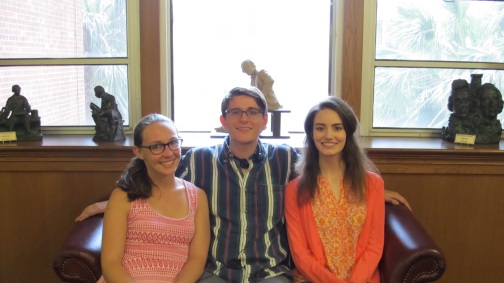
Blaise
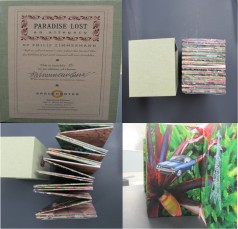
“My name is Blaise Denton and I have been working here for a little under two years. I had walked into Special Collections before, but been scared off by an unfriendly and perhaps confused receptionist. When I came back for my interview, Lisa Girard was so friendly and painted such a glowing picture of Special Collections, I was excited to work here. My first week I went through the Special Collections Vault, pulling out and examining the rarest and most valuable books in the collection. It was incredible. There were ancient pirate biographies, 4,500 year old stone sale receipts and [Salvador] Dali paintings. It was like being in a museum, except you can touch the art and you’re getting paid. The artists’ books are definitely my favorite collections. All the books that fit under N7433 are designed less to be read but more as pieces of art. They’re beautifully made and bizarrely interesting.
After graduation I am hoping to go to graduate school here at FSU, for Urban Planning and Public Administration. I am going to be very sad to leave Special Collections. This is by far the best job I’ve ever had. If there were one thing I wish more people knew about Special Collections it would be that we want you to come in and we are happy when you get to look at something unique.”
Shelby
“Prior to working at FSU’s Archives and Special Collections, I was a little apprehensive about applying for the job. While I loved all literature, I knew very little about what occurred “behind the scenes” of a library and did not feel completely qualified to fill the position. As I began my work, throughout the following months, I immediately felt at ease. Although I did not know the ins and outs of Library Science my supervisor Lisa Girard, as well as other staff, showed me all that I needed to know. I felt welcomed, supported and appreciated and to this day I feel that is what facilitated my growth of knowledge and passion in this field.
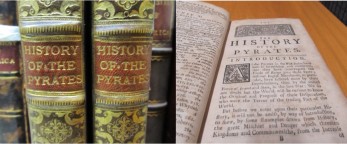
I generally love the items that are located in the vault. My favorite book however is volume one of A General History of the Pyrates from 1724. On my mother’s side of the family, one of our ancestors is Bartholomew Roberts- a notorious pirate. It was incredible getting to read all of the family stories about him in this book! I would say that my favorite project is any sort of reshelving or pulling a work for a patron. It is like a scavenger hunt replacing an item or looking for the call number! I tend to make a game out of anything.
Working in Special Collections helped me to develop a deeper appreciation for the text I read as an English Literature major. The ability to know firsthand about how books were created during the Renaissance, for example, is simply priceless. After graduation, I plan on staying in Tallahassee and continuing to work in Special Collections until the end of July. Then, I intend on moving to Jacksonville to attend the University of North Florida for my MA in English. Eventually I hope to teach high school English, Theatre, and German.
I think that the most important thing that I would want people unfamiliar with Archives and Special Collections to know is simply all that we have to offer and how easily accessible everything is. I tell people all the time about the amazing glimpses into history that I get to hold (with utmost caution, of course!) in my hands, and that the same materials are available to them as well! People think that we only have very old and specific books, but our variety spans centuries and it is always growing!”
“Does wisdom matter?” Robert Frost asks. The answer is a resounding, No! America’s most famous poet, being honored at this 1958 Poetry Society dinner, forcefully tries to disassociate himself from the public’s image of him as a bardic sage. “I can’t describe myself as I’ve heard myself described,” he says, referring to the preceding testimonials (which are not included in this record of the event.) He then somewhat contradicts himself by addressing what he considers the essential problem of mankind: the anxiety we feel “lest the spirit should be lost in the material.” We all experience this anxiety of being too material. Just look at the scales people now have in bathrooms! But we cannot shy from the material, either. “God, at the risk of spirit, descended into flesh.”
Turning to poetry, he twits his colleague John Crowe Ransom who complained that Frost always “writes on subject.” “Yes,” Frost retorts, “and you write on bric-a-brac.” He defends the use of rhyme and meter (Howl had just been published two years ago) and then reverts to his own fears that the material will “clog” his spirit. He speaks of the late psychiatrist and poet Merrill Moore who, when Frost would complain of this or any problem, would counsel, “You must do the best you can.”
Frost looks back over his career, saying “I had so much luck,” and then turns to what is clearly the main event of the evening, a reading of his poems. But he does not “read” or “recite.” As always, with Frost, he makes a point of announcing that he will “say” a few poems, neatly emphasizing how much the quiet, spoken voice permeates his poetry. It is the music of a man “saying,” not singing or declaiming. Working from memory, he stumbles a few times (Frost was eighty-four) but still leaves a valuable record of the way he intended his poems to sound. He makes some interesting asides, particularly about Mending Wall. When taxed by an English novelist about the line “Good fences make good neighbors,” he defended himself by saying, “I was only quoting!” And when he gets to the lines:
Something there is that doesn’t love a wall,
That wants it down. I could say “Elves” to him,
…he says, in an aside, “…as Yeats would.”
There is then a break in the recording. Two poets are summoned up to the dais. It is not clear if their tributes took place before or after Frost’s reading. John Ciardi reads “A Sonnet for Robert Frost” and Donald Hall reads his sonnet, “T. R.” The recording then breaks off abruptly.
Robert Frost was born in 1874. His career was slow in taking off—he worked as both a school teacher and a farmer—but when it did, first in England, then in the United States, he quickly rose to become not only the nation’s preeminent poet but its most popular as well. The reasons for this are easy to see. He achieved the almost impossible-sounding feat of fusing the simple, homespun voice of a skeptical, modern, unpretentious man with the commonly accepted devices traditional poetry. The website poets.org describes this seeming contradiction:
Though his work is principally associated with the life and landscape of New England—and though he was a poet of traditional verse forms and metrics who remained steadfastly aloof from the poetic movements and fashions of his time—Frost is anything but merely a regional poet. The author of searching and often dark meditations on universal themes, he is a quintessentially modern poet in his adherence to language as it is actually spoken, in the psychological complexity of his portraits, and in the degree to which his work is infused with layers of ambiguity and irony.
In his performance at this dinner, as he did in countless appearances throughout the country, Frost reinvents the notion of the public poet not by stressing a social or political agenda but by offering his poetry as a spoken remedy, as embodying possible clues to curing whatever ails the listening audience. The website of the Poetry Foundation lauds how:
He wanted to restore to literature the “sentence sounds that underlie the words,” the “vocal gesture” that enhances meaning. That is, he felt the poet’s ear must be sensitive to the voice in order to capture with the written word the significance of sound in the spoken word.
By the time of this dinner, Frost had attained an iconic status unheard of for 20th century poets. What differentiates him from subsequent “media creations” of our time is perhaps the degree to which his reputation was based solely on his books and readings. He did not endorse toothpaste, appear in films, or host a radio show. As The Paris Review noted a few years later, when choosing him as one of its first poets to interview:
The impression of massiveness, far exceeding his physical size, isn’t separable from the public image he creates and preserves. That this image is invariably associated with popular conceptions of New England is no simple matter of his own geographical preferences. … His special resemblance to New England is that he, like it, has managed to impose upon the world a wholly self-created image. It is not the critics who have defined him, it is Frost himself.
Robert Frost died in 1963.
Audio courtesy of the NYC Municipal Archives WNYC Collection.
WNYC archives id: 8733
Municipal archives id: LT7888
Special Collections has recently acquired an eye-popping addition to our Whaling Collection: Das Jagen, Fangen, Zähmen und Abrichten der Thiere, a 19th century German children’s book about hunting animals. (The title translates as “The Hunting, Catching, Taming and Dressing of Animals”.)

The book’s frontispiece shows a spectacular, full-color whale-hunting scene, complete with befuddled walrus, spectator seagulls, and a very morose whale with a baleen mustache.
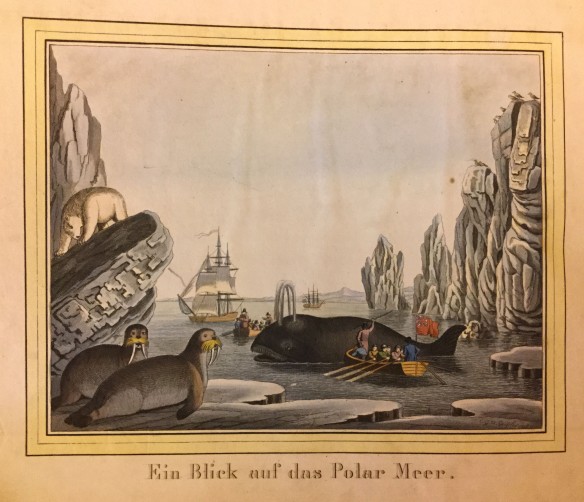
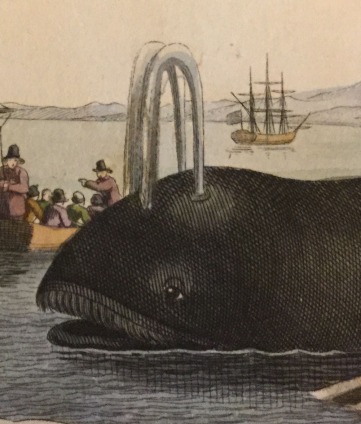
(Let’s pretend those dual arches are an exaggerated version of the southern right whale’s “characteristic double spout“, and/or that the sad whale is blocking our view of a smaller, simultaneously-spouting cetacean.)
This generally text-heavy book contains five plates, each of which bears nine tiny engravings. (I don’t recommend scrolling through the following section of engravings if you are 1) a small child, despite the fact that this is a children’s book, or 2) of a delicate constitution.)
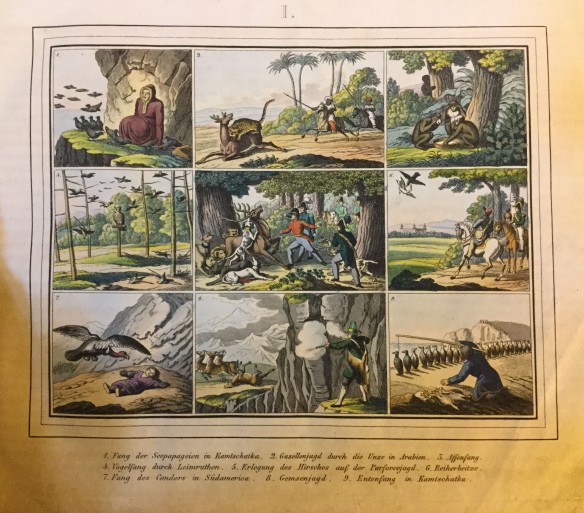
The engravings, as you’ve likely gathered from the above, exhibit all manner of grisly ways in which humans kill other animals (some of which I consider anthropologically suspect, but I’m not a hunting expert).
For instance, there’s the old “bear impaled on a spiky board” trick:
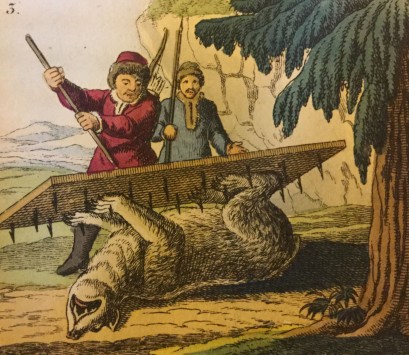
There’s also the “scaring seals with weird faces over a grassy cliff onto curved spikes” approach:

And, lest we forget, the “whipping birds while mounted upon a galloping horse” technique:
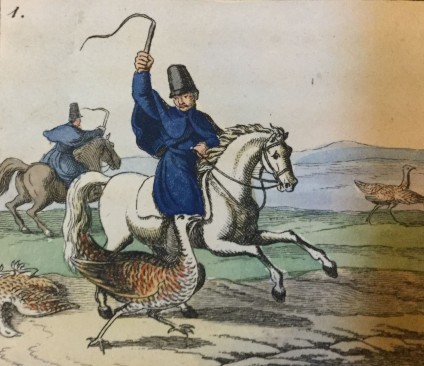
The digitized book can be viewed in its entirety online, either here or here. If you do look over the digital version (or come to Special Collections to view our copy in person), I challenge you to find the engraving of the sneaky person hunting reindeer while dressed in a reindeer suit. Really.
Andy Warhol and Norman Rockwell had very different approaches to their work.
Rockwell painted magazine covers for Look and the Saturday Evening Post. These were funny, beautifully realized illustrations of everyday American life. A girl with a black eye, beaming on a bench outside the principal’s office. A family saying grace in a diner. Accessible, relatable images.
Warhol, in his Factory, pushed the boundaries and the buttons of the art world with mass-printed images.
They had a lot of differences… but also a lot in common.
Back in the 1970s, Douglas Cooper interviewed artists, authors and scientists for a series of radio shows. They were broadcast by Iona College and syndicated to a number of stations, including WNYC. He spoke to everyone from Salvador Dali to B.F. Skinner.
In Cooper’s interviews with Rockwell and Warhol, the two artists keep touching on similar themes and questions. Whether their work is art. The value of an award. Capturing and communicating the everyday. It’s just that the way that they interpret those themes is very, very different.

We are excited to announce that the College of Nursing Collection, 1948-2014, is now available! The College of Nursing Collection finding aid can be viewed on Archon, our Finding Aid Database, and selections from the collection have been digitized and are available on DigiNole.
The College of Nursing Collection consists of papers, ephemera, and photographs that document the history and activities of Florida State University’s College of Nursing from its development in 1948 through 2014. The collection includes records from the deans, the graduate nursing program, various faculty committees, student organizations (Student Nurses Association and Sigma Theta Tau), and the Legacy Project, as well as materials created for special events such as pinning and graduation ceremonies, homecoming events, conferences, and presentations.
In early 1950, Florida’s Board of Control (the predecessor of the Board of Regents) approved the establishment of a School of Nursing at Florida State University and appointed Vivian M Duxbury as the first Dean of the School. By September, the School of Nursing admitted its first students: a group of twenty-five young women. FSU’s SON was only the second collegiate school of nursing to be set up in Florida, with the first at FAMU.
In 1952, the School of Nursing awarded its first degrees to three women students. In the fall, faculty members Agnes Salisbury and Karleen Gillies began teaching the first extension courses in Jacksonville and Miami, respectively. In 1958, the SON became the only nursing school in Florida accredited by the National League for Nursing and was one of less than 100 in the nation.
At first, there was no particular building reserved for the nursing program; offices and classes were held in various buildings around campus. The School of Nursing moved into its new building, Vivian M Duxbury Hall, in the fall of 1975. The most recent milestone in the nursing program’s history is the change of its name from “School” to “College” in the summer of 2006.
To see more photographs, ephemera, and artifacts related to the history of Florida State, check out the FSU Heritage Protocol Digital Collections or like the Heritage Protocol Facebook page.
In honor of the just-past May Day holiday, we’ve pulled items representing work and workers for this week’s open research hours. Swing by before 1:00 today (or make an appointment any time) to see these in person!
Above, from L-R: image from Old London Street Cries and the Cries of To-Day (London: Field & Tuer, 1885); title page from John Gay; Or, Work for Boys (New York: Hurd and Houghton, 1864); image from an untitled Italian book of men and women dressed for different occupations (let us know if you know more about this one!).
Here’s the table of contents from Charles Quill’s The American Mechanic, published in 1838.
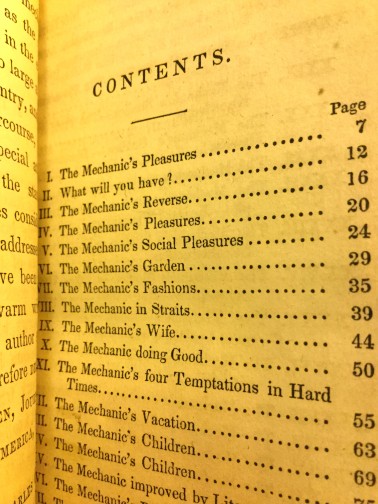
Fun fact regarding this book: the Providence Public Library was founded in 1871 when members from The Franklin Society, The Rhode Island Society for the Encouragement of Domestic Industry, The Franklin Lyceum, and the Association of Mechanics and Manufacturers joined together to form a free public library (and art gallery and natural history museum). When the library first opened its doors in 1878, its collection contained a great number of books from the Mechanics’ Library. Many of those books are still here today, housed in Special Collections, and identifiable by the Mechanics’ Library stamp on the title page. Here’s the (rather faded) evidence that The American Mechanic was part of PPL’s original collection:
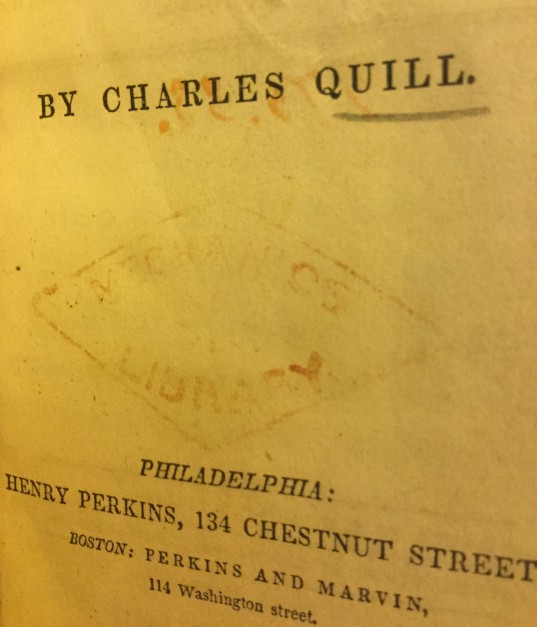
For those with a deeper interest in Rhode Island labor history, I recommend checking out some of the labor-related images in our digital collections. I also highly recommend the gorgeous and heartbreaking collection of digitized photographs from the National Child Labor Committee Collection at the Library of Congress. You can search within that collection for photographs taken in Rhode Island, of which there are more than 100. (These investigative photographs were taken by Lewis Hine between 1908 and 1924, while working for the nationwide National Child Labor Committee. They’re an incredible glimpse into the lives of factory and textile workers, as well as immigrants and working class families, in the early 20th century.)
From 1958 to 1968, New York-area radio audiences made time on Sunday mornings to listen to the friendly and informative voice of Alan Wagner on the program Living Opera, which he wrote, produced and hosted. For its ten-year run on WNYC AM and FM, Wagner played new recordings and interviewed hundreds of luminaries from the music world. From Rudolf Bing to Eileen Farrell to Franco Corelli to Eleanor Steber, during that period virtually every major operatic name passing through New York appeared on Living Opera at least once. Listen here to his brief talk with the great soprano Licia Albanese.
Most of these interviews were recorded at his home or office. Sometimes, though, he had to travel to wherever the subject was, carrying a bulky reel-to-reel tape recorder with him. On one notable occasion, he drove to Idlewild Airport (now JFK International Airport), young wife and baby son in tow, to record a conversation with Richard Tucker before the great tenor had to catch a flight. The program had to be carefully written and timed in order to fit into its allotted slot, and for that reason it was almost always pre-recorded on Thursday nights, and delivered to WNYC on Friday mornings. There was one notable exception: the Sunday in 1960 after the great baritone Leonard Warren passed away suddenly during a performance at the Metropolitan Opera. On that occasion, the program was quickly rewritten and was broadcast live from WNYC’s studio.
In 1961, he published — with research assistance from his wife Marti, herself a professional in an opera-related field — a lively book of anecdotes, Prima Donnas and other Wild Beasts, a favorite among opera fans to this day. So great was Alan Wagner’s love of opera, The New York Times later that year reported on his pre-empting of his regularly scheduled Sunday program to scold “all parties concerned in the current Met labor negotiations,” for the apparently cancelled Met Opera season. Citing them with “indefensible intransigence,” he charged that “opera lovers may have been had.” [1] At the eleventh hour an accord between the Met and its musicians was reached allowing for the 1961-1962 season of performances. Living Opera ended only because Wagner’s burgeoning career as a television executive required a move to Hollywood. Opera was Wagner’s passionate avocation. Professionally he was a renowned and award-winning television programmer, producer, and consultant. After active duty in the Navy and a tour of the U.S. as a stand-up comic with the Navy Talent Show, which included a live appearance on “The Ed Sullivan Show,” he found work in the television department of advertising agency Benton & Bowles. In 1961 he moved to CBS, rising to become a senior creative executive. In his time at CBS he developed such now-classic series as All in the Family, M*A*S*H, Kojak, The Waltons, and The Mary Tyler Moore Show. He was also responsible for many arts-related broadcasts, including Vladimir Horowitz: A Television Concert at Carnegie Hall and Sills and Burnett at the Met, and for the cultural landmark specials A Charlie Brown Christmas and How the Grinch Stole Christmas. In 1982 he was appointed the first President and CEO of The Disney Channel. After establishing the channel’s successful creative and business plan, he left to form an independent film and television production company, Alan Wagner Productions, also known as Boardwalk Entertainment, which has produced films and series for HBO, CBS, ABC, Hallmark, Lifetime, and other outlets, and consulted on creative and new-network development for clients such as Cablevision. He was honored by the Writers Guild of America and the National Academy of Television Arts & Sciences for his rich and successful body of work.
Even after Living Opera ended, though, Wagner remained a presence in the opera world. In the late 1970s and early ‘80s, back in New York, he was the host and commentator for multiple New York City Opera radio-broadcast seasons. More recently, he made regular appearances on the Metropolitan Opera broadcast intermissions. His on-air highlights include an interview with James Levine, and talks on Richard Wagner as a closet feminist, how to be a Jewish Wagnerite, the devil figure in Romantic-era Europe, and the theology of Parsifal. He served as both moderator and panelist on numerous opera quizzes, hosted a Richard Wagner retrospective for a Season Preview broadcast, paid tribute to the late Robert Merrill, and participated in several round tables, including one on the guilty pleasures of a record collector, and another that he moderated which featured the great African-American divas Martina Arroyo, Reri Grist, Shirley Verrett and Grace Bumbry. For the Met Opera website, Wagner interviewed beloved broadcaster Peter Allen on the occasion of his retirement. For the Conductors Guild, he was a panelist for a Great Conductor Retrospective program on the Metropolitan Opera. He was also a hugely popular lecturer, and enjoyed giving colorful and informative talks on a broad range of operatic subjects for The Metropolitan Opera Guild, The City University Graduate Center, and the Wagner Society of New York. He wrote for Opera News and the Metropolitan Opera Playbill. His writing also appeared in such publications as High Fidelity, Musical America, Stagebill, Reader’s Digest, and the New York City Opera souvenir program. Alan Wagner passed away in December, 2007, but left behind a powerful legacy of music fans who joyfully learned to love opera and other classical musical forms because of his infectious passion for the arts, his warm personality, and his talent for communication. As he once told The New York Times, his WNYC radio show was “not a hobby, it’s a passion. There are no lukewarm opera lovers. You can’t ‘kind of’ like opera.”[2]
_________________________________________
Thanks to the Wagner family we are currently digitizing some 38 reels of interview tapes from Alan Wagner’s WNYC program. While we’ve not finished with all the descriptions and cataloging, you can listen to them at: LIVING OPERA._________________________________________
[1] Hammel, Lisa, “Alan Wagner of WNYC Show Scolds All Concerned in Possible ‘Met’ Cancellation,” The New York Times, August 14, 1961, pg. 45.
[2] Hammel, Lisa, “TV Man With Sideline,” The New York Times, December 31, 1961, pg. X15.
Original Living Opera press release from April 1, 1958.
(Thanks to Susan Wagner/WNYC Archive Collections)
The division of Special Collections and Archives, of Florida State University, is privileged to have the assistance of our undergraduate student assistants in addition to our graduate assistants. In coordination with our Manager of Special Collections, Lisa Girard, our undergraduate assistants may also work between Heritage Protocol and University Archives (HPUA) and the Claude Pepper Library. Our undergraduate student assistants comprise a variety of different majors, have spent many semesters in our division and are imperative to our daily operations. The first of two posts, that follow, serve as our means of honoring them as well as reflecting on their time spent here as they graduate and become alumni of FSU.
“My name is Mary Kate Downing and I’ve been an student assistant in Special Collections and Archives for the past two semesters. I’m graduating this semester, so I was thrilled to learn that I’d have the chance to write a part of a guest blog post as a way to reflect on the fantastic time I’ve had here.

I first learned about Special Collections and Archives in spring 2015 from one of my professors, Dr. Davis Houck of the School of Communication. I was in Dr. Houck’s speech class and wanted to give an informative speech on the history of FSU’s Westcott Building and Fountain. He encouraged me to pay Special Collections a visit. I had not heard of the division before, but I wanted to do some research for my speech, so I took the plunge and walked through the fancy wooden door. Everyone I met from the division was friendly and helpful and I was able to find more than enough information for my speech. The rest of that spring semester was extremely busy, so I didn’t think too much about Special Collections again until the end of the summer when I was applying for jobs for the fall. I was looking for a part-time library job because I already knew that I wanted to be a librarian, but I had only previously worked at public libraries. With my fingers crossed, I filled out the application to work at Strozier Library checking off that I was interested in almost every division, including Special Collections. I was invited to interview for positions in three different divisions, but I was the most excited about my Special Collections interview. As you can imagine, then, I was elated to eventually be offered a position in the division!
When I started working at Special Collections and Archives, I realized that the division

didn’t only have materials related to FSU history. I learned about the huge variety of manuscripts, rare books, maps, sound recordings, ephemera, and more that call Special Collections home. I was impressed. I couldn’t believe that all of those materials were readily available for people to look at. I was so excited to be able to interact with items, ranging from a Napoleonic death mask to letters written by Dr. Seuss, on a daily basis. During my two semesters here, I’ve had the opportunity to work on a variety of different projects in three divisions of Special Collections and Archives – general Special Collections, Heritage Protocol and University Archives (HPUA), and the Claude Pepper Library.
Some of my favorite projects in general Special Collections have included different inventories, like the Dirac book cart inventory, where we went through carts of books and journals that belonged to late Nobel laureate and FSU professor Paul A.M. Dirac. As well as the vault inventory, where I made sure all the especially valuable materials in Special Collections were accounted for.
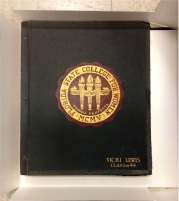
In HPUA, my main project was creating a comprehensive timeline of FSU history using primary source documents. In searching for primary sources, I came across a lot of awesome FSU-related materials, like the enormous Victoria J. Lewis scrapbook and the 1968 edition of the FSU yearbook Tally-Ho.
At the Claude Pepper Library, some of my favorite projects have included the CDA to WAV conversion, where we worked to convert CD recordings of late Florida Senator Claude Pepper to digital files, and the ongoing inventory, where I went through almost a hundred boxes of Senator Pepper’s correspondence and mementos from 1936 to 1951. I also enjoyed working with the collection of phonodiscs, which contain the original recordings of many of Senator Pepper’s speeches and interviews, and a program from the 1944 Democratic National Convention that was in one of Senator Pepper’s correspondence folders.
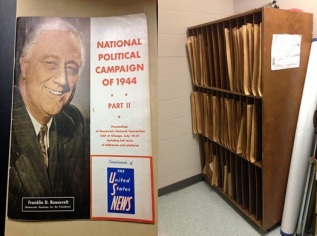
After graduation, I will be earning a master’s degree in Library and Information Science from the University of South Florida and working part-time in the Youth Services Department at a public library in the Tampa area. I’ll miss FSU’s Special Collections and Archives, but I plan to look for another special collections or archives position in the near future. If I could tell people who are unfamiliar with Special Collections and Archives one thing about the division, it would be to come check it out! Don’t be intimidated by the door that separates the Special Collections Reading Room from the rest of Strozier Library. There’s so much you can learn, and the librarians and archivists are some of the coolest people on campus.”

Catalogers work behind the scenes in the library. We’re usually found in our very quiet building, examining books, checking over bibliographic records, or typing lines of code. The catalog records that we work on are mostly used by people whom we will never meet. But the Cataloging & Description department occasionally receives questions from researchers, and those questions help explain why we put certain pieces of information into our records.
For example, we recently got a question about the historical theses and dissertations that we catalog. A researcher compiling a bibliography of theses and dissertations for The Hymn Society found the record for a thesis or dissertation written by an FSU student in 1973. The question was: was it a thesis, written for a Master’s degree, or a dissertation, written for a Ph.D.?
As technology has advanced, catalogers have been able to provide an increasing amount of metadata for each item they catalog. We no longer have to limit ourselves to the space of a 3×5-inch catalog card, and changes in our digital platform have allowed us to include more information for electronic resources as well. The record in question had been created in 1976, using older cataloging standards, and it didn’t contain the information that the researcher wanted.
As we’ve been updating the records of historical theses and dissertations to current standards, however, we’ve been including this information in each record. Once we got the question from the researcher, we updated this record as well, so that now anyone looking at the record should be able to see that it’s describing a dissertation, not a thesis.

Yesterday marked the last class visit to the Archives & Special Collections for the Spring 2016 semester. The class was “Early Women Writers” taught by Amherst English Professors Amelia Worsley and Ingrid Nelson, and it was a great excuse for me to dig into our collections to see what we have in this area.

This rather plain looking four-volume set was one gem I was well aware of in our collections. Although it may not look like much from the outside, this is the original publisher’s binding on a completely untrimmed first edition of Jane Austen’s Northanger Abbey and Persuasion. The Archives holds a complete set of Austen’s novels in first edition.

Austen died in July 1817. Even though this set includes a “biographical notice of the author,” he name still does not appear on the title page. By contrast, Charlotte Smith (1749-1806) does get her name on the title page of The Banished Man, one of ten novels she published in the late eighteenth century.

Curiously, we only hold volumes 3 and 4 of The Banished Man. Stepping back a little further in time, we have a copy of Sarah Fielding’s The Adventures of David Simple published in 1744.

I’m curious if the first edition of David Simple included the Preface by the author’s brother, and best-selling novelist of the age, Henry Fielding. The number of editions of a work is one way to gauge its popularity; the last two novels had at least two editions; this copy of Aphra Behn’s collected works — All the Histories and Novels — was in its sixth edition in 1718:

Behn died in 1689, so the demand for at least six editions of her collected works nearly 30 years after her death is an excellent indicator of her popularity.
The very earliest published book in the collection written by a woman appears to be Anne Bradstreet’s The Tenth Muse Lately Sprung Up in America published in London in 1650:

Our copy lacks a few pages at the front, which have been replaced by facsimiles, but the very last page of the book is very special:

I have not even attempted to decipher the handwriting here. Sounds like a good student project…
Jumping back to the Romantic Era, our copy of Mary Wollstonecraft’s Letters Written During a Short Residence in Sweden, Norway, and Denmark has the signature of its former owner on the title page:

This copy once belonged to William Wordsworth and is now part of the Cornelius H. Patton, Class of 1883 Wordsworth Collection.
We do not hold a copy of the first edition of Phillis Wheatley’s Poems on Various Subjects, Religious and Moral (London 1773), I was pleased to learn we have this 1834 edition of Memoir and Poems of Phillis Wheatley.


The title page dedicates this volume to “Friends of the Africans” and it was published the year after William Lloyd Garrison founded the American Anti-Slavery Society in 1833.
A final gem in our collections is also authored by a woman of color: Narrative of Sojourner Truth, a Northern Slave (Boston: Printed for the Author, 1850).

Like many of the books in our collections, this one bears the marks of having spent part of its life in the Frost Library circulating collections:

We will leave the old library “tattle-tape” attached to the title page of this copy until we can pay for the careful conservation treatment it will require to remove it. At least our copy still has the portrait.
While we do not have a vast collection of women writers, it’s always rewarding to find out that we have some fascinating high spots. I’ll end with this example of provincial printing from the early nineteenth century.

Susanna Rowson’s Charlotte Temple was first published in 1790 and was the best-selling novel in the United States until Uncle Tom’s Cabin appeared in book form in 1852. This edition was published in Brookfield, Massachusetts. It’s likely E. Merriam & Co. printed up a couple hundred copies of this best-seller to satisfy local demand and make some easy money.
Thirty years ago on May 2, 1986, Vancouver’s World’s Fair, Expo 86, was officially opened by TRH Charles, Prince of Wales and Diana, Princess of Wales. Originally known as Transpo, Expo 86’s theme was “Transportation and Communication: World in Motion – World in Touch”. The 173-acre exposition site featured 65 pavilions representing countries, provinces and territories, and corporations.

Expo Centre, August 1986, Ernie Reksten. Reference code: AM1551-S1-: 2010-006.440

Expo 86 Information Board, Ernie Reksten. Reference code: AM1551-S1-: 2010-006.396
While the official records of the Expo Corporation are part of the holdings of the BC Archives, we do have some related materials in our holdings. Here’s an overview of what we have.
Expo 86 ads by Yaletown Productions. Reference code: AM1553-8-S7-: MI-351

Expo 86, Ernie Reksten. Reference code: AM1551-S1-: 2010-006.397

Looking north at Expo site and fireworks barge moored in False Creek, Ernie Reksten Reference code: 2010-006.437
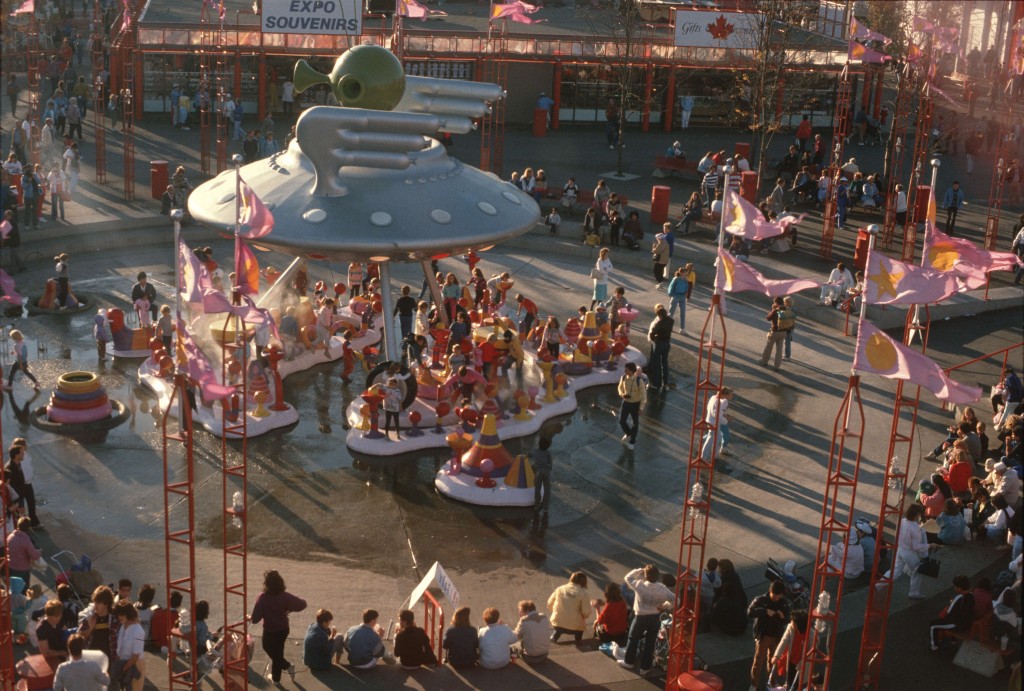
Expo 86 water park – UFO-H20, Ernie Reksten. Reference code: AM1551-S1-: 2010-006.401
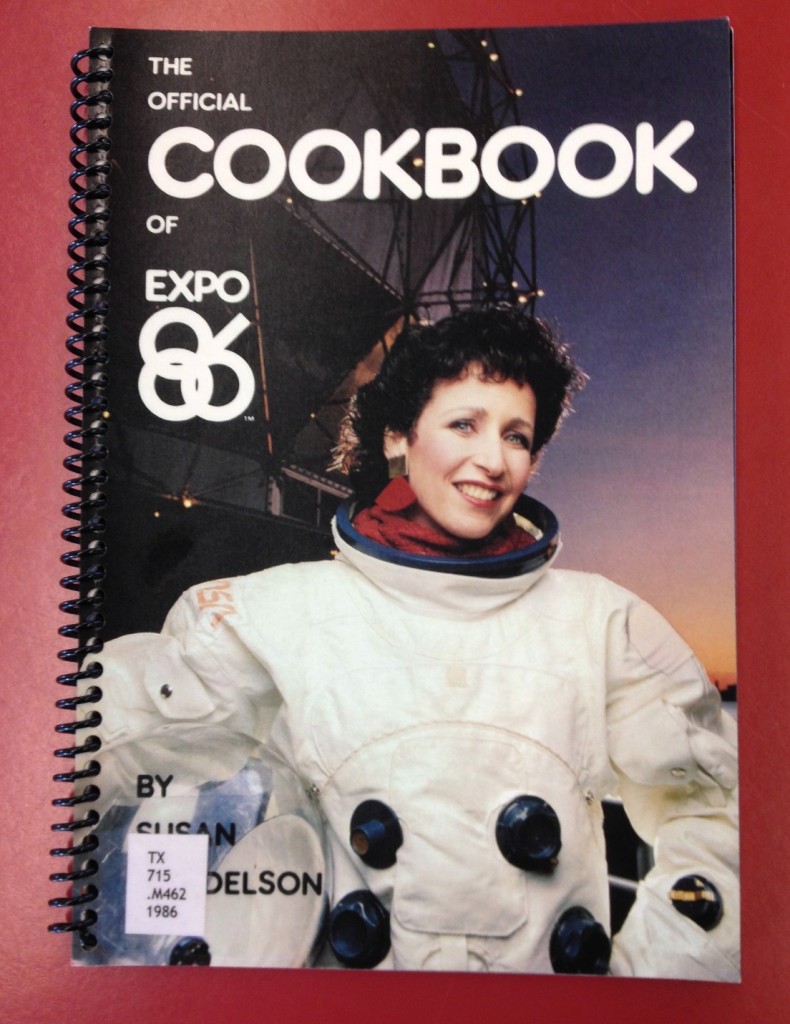
Cover of the Official Expo 86 Cookbook by Susan Mendelson and food photographer Derik Murray. Reference code: TX 715 .M462 1988.
The six-month-long exposition closed October 13, 1986 with a final attendance of 22,111,578 visitors.

Expo 86 gondola and crowds, Ernie Reksten. Reference code: AM1551-S1-: 2010-006.392.
Please let us know if you’ve found these resources useful. And we’d love to hear about your own memories of Expo 86!
[Editor’s note: This post was written by Jana Grazley and Christine Hagemoen]
I don’t know about all of you, especially if you’re reading this in Australia, but I’m pretty darn excited that it’s finally spring.
The flowering trees here in Providence are really doing their thing.
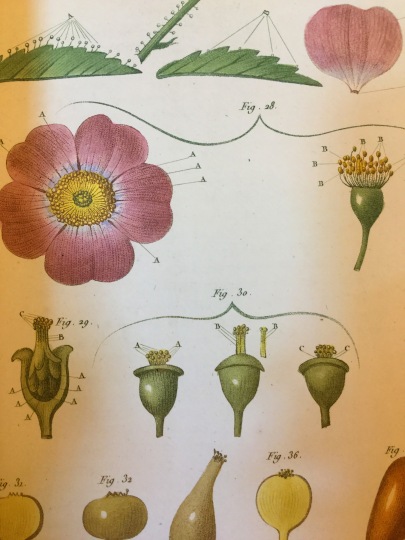
Illustration from Les roses: peintes par P.J. Redoute, decrites et classees selon leur ordre naturel par C.A. Thory (Paris, 1835). Yes, I know that a rose is not technically a flowering tree.
People are throwing open their windows and doors, and flooding out onto the sidewalks.
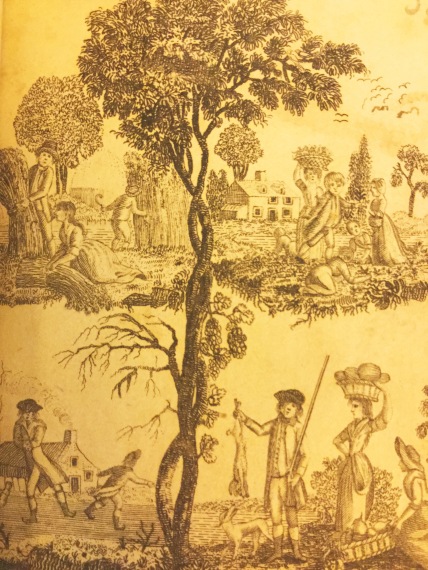
Frontispiece from James Thomson’s The seasons: containing, spring. summer. fall. winter (Philadelphia, 1795).
Baby animals are being small and hilarious.

Nothing to do with Special Collections, everything to do with ducklings in ramekins, via GIPHY.
People are sweeping off their driveways, painting their fences, and pressing seeds into the ground. Here’s a 100% accurate description of me in my garden, courtesy of Henry Ward Beecher’s 1857 Plain and pleasant talk about fruits, flowers, and farming:
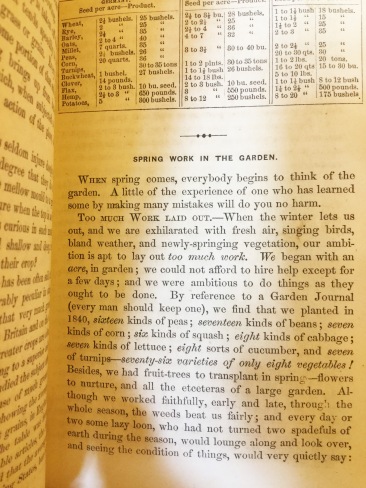
When the winter lets us out, and we are exhilarated with fresh air, singing birds, bland weather, and newly-spring vegetation, our ambition is to lay out too much work. We began with an acre, in garden… By reference to a Garden Journal (every man should keep one), we find that we planted in 1840, sixteen kinds of peas; seventeen kinds of beans; seven kinds of corn; six kinds of squash; eight kinds of cabbage; seven kinds of lettuce; eight sorts of cucumber, and seven of turnips… Although we worked faithfully, early and late, through the whole season, the weeds beat us fairly.
You shall not discourage me, Henry Ward Beecher! I’m planting fifteen more kinds of peas as soon as I get home from work today.
Enjoy the warm(er) weather, dear readers, stop by Special Collections to look at historical field guides to flowers and sea shells, and stay tuned for a blog post on the most questionably-themed historical children’s book we’ve seen to date.
The film I Am Twenty (Mne dvadtsat’ let), directed by Marlen Khutsiev, follows Sergei, a young man recently returned home from serving in the military. He reconnects with his friends only to find that they are drifting apart into their own versions of adulthood. He meets Anya during a May Day parade, and as their relationship becomes more serious, they struggle to find common ground between his modest, working class world, and her urban intellectual world. This production of Radio Moscow dramatizes a selection of scenes from the film in English.
Though the film began production in 1959 during the Khrushchev Thaw, a nationwide movement of creative freedom, the final release in 1965 was censored to half the original three hour run time and given the title I Am Twenty. The original title Ilyich’s Gate (Zastava Il’icha), meaning “Lenin’s Gate” or “Lenin’s Guard,” is taken from an industrial neighborhood in Moscow where the film takes place.
Khutsiev’s version was interpreted by the government as too critical of Stalinism and portrayed Soviet youth as pessimistic, westernized and disrespectful of elders. In 1963, Khrushchev singled out the film in a public lecture to roughly 600 artists and writers:
Even the best of the characters – the three young workers – do not personify our wonderful youth. They are shown as not knowing how to live or what to live for. And this at a time of all-round building of communism, a time illuminated by the ideas of the Communist Party Program!
These are not the sort of people society can rely upon. They are not fighters, not remakers of the world. They are morally sick people, who have grown old while still young, who have no high aims or vocation in life…
The idea is to impress upon the children that their fathers cannot be their teachers in life, and that there is no point in turning to them for advice. The film-makers think that young people ought to decide for themselves how to live, without asking their elders for counsel and help.[1]
Given this vilification from the highest office, it is curious that Radio Moscow would distribute a segment about this film to western audiences. The host in this recording applauds the filmmaker:
There are film directors who turn out movies as quickly as they are forgotten by the audiences. There are others, however, who work long and painstakingly on a picture. Their films can rightly be considered works of art. This is true of the young Soviet director Marlen Khutsiev, who has only three films to his credit, but all of them have had a great impact on our audiences.
I Am Twenty shares many stylistic and thematic similarities to French New Wave, Italian neorealist and German rubble films made in Europe in the wake of WWII. For example, Khutsiev uses long tracking shots, non-professional actors and documentary style footage taken at public locations. The young characters amble through day-to-day life pondering existential questions. I Am Twenty follows a disillusioned soldier returning home from military service, still reconciling his family’s experience during the war with modern comforts and opportunities. The film opens with three men in WWII uniforms walking down an empty cobblestone street. As they march into the distance, three figures take their place, this time casually approaching the camera in modern attire. Next we follow Sergei in his modern military uniform returning home through eerily quiet streets.
Historian Joan Neuberger notes,
…the twenty-somethings we’ve been hanging out with were members of the first generation to come of age after the war. Their search for purpose suddenly no longer seems purely ideological, materialistic, or individual. They are, in fact, each shadowed by the devastation of war-time loss even as the richness of their everyday experiences seems to have put the war behind them. [2]
Though liberally rewritten to fit with nationalist doctrine, the scenes dramatized by Radio Moscow illustrate Sergei’s post-war existential crisis. In the first scene Sergei and Anya reject the bourgeois lifestyle of her parents. This contrasts with the next scene in which Sergei’s mother describes digging for potatoes on the front lines to feed her hungry family during WWII after misplacing food rations. This causes Sergei to explode with anger in the following scene, at Anya’s birthday party, when one of her friends dismissively steps on a potato. In the final scene, Sergei confronts a vision of his father, a soldier who died during WWII. Sergei begs him for guidance on how to live his life, “…I was only 21, so how can I advise you,” he responds.
The radio adaptation attempts to bring a resolution to the film. As his father disappears, Sergei proclaims, “…the most important thing in life is not to be alone. Alone one is helpless. I must live for Mother, for Vera, for Anya. I must live for all people and only then I will be a real person.” This film, however, is purposefully vague. The audience does not see what becomes of Anya and Sergei. Like these characters, we are left to decide for ourselves.
I Am Twenty is available to rent or purchase on Amazon.
[1] Woll, Josephine, Real Images: Soviet Cinemas and the Thaw, 2000, pg. 146-147
[2] Neuberger Joan, “I am Twenty (1961, released 1964)“, Not Even Past, 2011
Audio courtesy of the NYC Municipal Archives WNYC Collection.
WNYC archives id: 150292
Municipal archives id: T4062
Cuando el software libre encuentra diversos intermediarios… El uso y posicionamiento de plataformas de software libre ha dado lugar al surgimiento de diversos servicios comerciales enfocados a facilitar a las Instituciones la implementación de estos sistemas, así como su adopción e integración dentro de sus procesos internos. Servicios como el alojamiento, configuración, migración de datos, […]
As I sit down to write my final blog entry as the Special Collections and Archives graduate assistant, I can’t help but think about the pivotal moment that started me down this whole career path.

It was the Fall semester of 2011 and I was the nerdiest college sophomore that you’ve ever met. I was completely obsessed with a class I was taking called Illuminated Manuscripts, which my brother still, to this day, jokingly refers to as “laminated manuscripts.” Once a week, our class would meet in one of the classrooms in Strozier Library to study the medieval facsimiles from Special Collections. The rare books librarian, who I thought had the greatest job in the whole world next to Alex Trebek, would administer over these extraordinarily recreated works of art as we students examined the pages with the unflinching attention of a neurosurgeon and took notes (in pencil, of course) on our discoveries.

The facsimile I found the most impressive was the iconic Book of Kells. Likely created around the year 800 CE on the Scottish island of Iona, the Book of Kells is widely regarded as the finest European medieval manuscript to survive. Comprising of the four gospel books of the New Testament, it is created in the Hiberno-Saxon, or Insular, style, which refers to a time period in post Roman Britain before the Viking Age when indigenous artistic conventions, such as stylized interlacing knot and animal motifs, were popular. There are a total of ten full page illustrations, including a whimsically blonde Christ and a vignette of cats eating the Eucharistic host, with numerous decorated initials and smaller abstract illustrations surrounding the text. The manuscript is massive, lavishly decorated, and constructed from the finest materials. Its pages are made of vellum, the highest quality calfskin parchment, and the colorful inks are made from a wide variety of imported materials. Ultimately, this manuscript is a showstopper. It’s the medieval equivalent of a modern day Ai Weiwei or Damien Hirst masterpiece.

And now as I wrap up my assistantship and prepare to graduate I realize I’m sincerely going to miss my friend, the Book of Kells, who sparked my interest in medieval manuscripts and beckoned me to pursue this opportunity in Special Collections. It’s true; those of us who seek a career in libraries envision being surrounded by the materials that we feel the most passionately about. And as great as blonde Jesus is, it’s the people of Special Collections that really make the department so special. Looking forward to commencement and the nebulous unknown of the “real world” that will follow graduate school, I honestly hope that I can find a work environment as supportive and team as cohesive as the one I’ve spent the last year with.
Cheers!
Did you know that UNCG Digital Collections has contributed over 37,000 items to the Digital Public Library of America?
If you’re not using DPLA, you should be. It’s a tremendous resource that pulls together digital collections from all over the United States and makes them available in one easy-to-use interface.
You can also see materials arranged by location on a zoomable map and via a timeline interface. The DPLA also creates exhibits on a regular basis, pulling together related items from different partner collections.
UNCG is proud to be part of this valuable resource.